Colombia is one of the best destinations to travel for vacation. It has everything you could ask for- turquoise water with white sand beaches, hot springs, waterfalls, jungles, deserts, cool misty mountains, a creative atmosphere, friendly locals and of course an abundance of coffee and chocolate… what more could an intrepid traveler want?
Before we get into the best places to go when traveling to Colombia for vacation, I want to cover some unique facts about the country and useful information that will hopefully further inspire you to move Colombia to the top of your travel list.
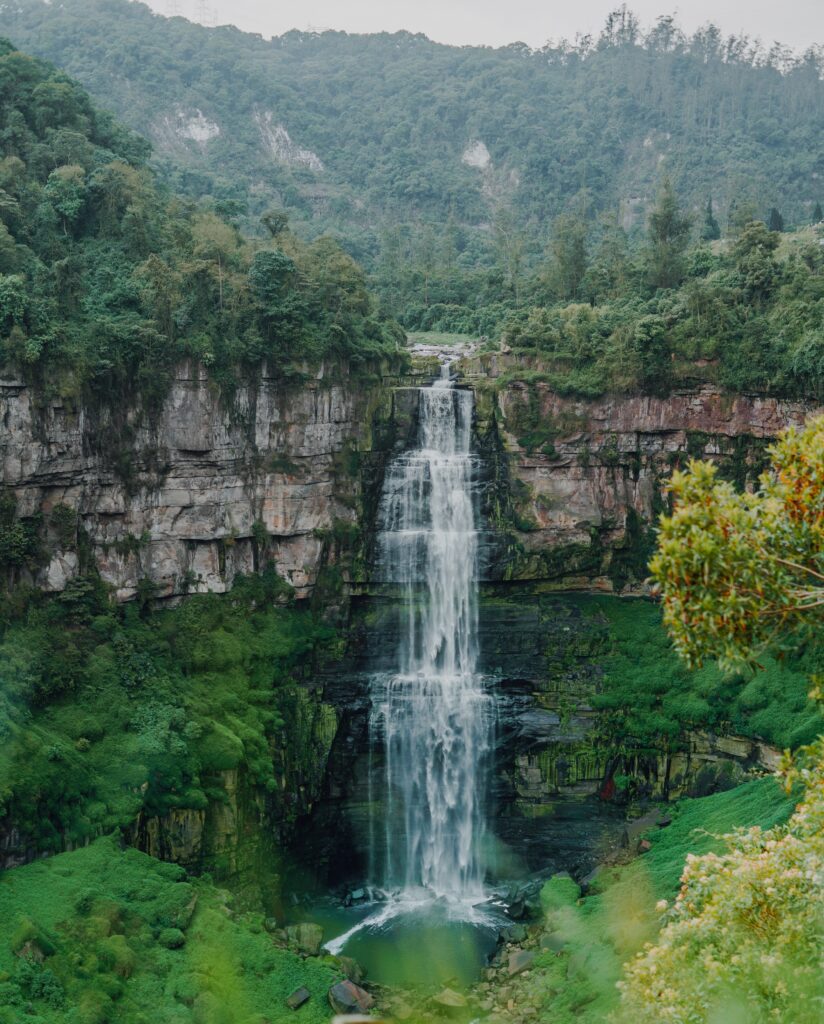
Facts about Colombia
- Colombia has some of the most diverse flora and fauna in the world
Colombia is home to the most extreme ecological diversity in the world. With over 50,000 types of plants and the most orchid, bird, and butterfly species on the planet, Colombia is the spot for botanists and wildlife enthusiasts. Colombia also is one of the largest flower exporters in the world so make sure to include a trip to Medellin’s wild flower market.
- Colombia is rich in natural resources
Colombia’s main exports are flowers, gold, emeralds, coal, petroleum, cacao, and coffee. Due to Colombia’s diverse biomes and a range in altitudes, thousands of different flowers grow effortlessly all over the country. Because of this, and the stable temperatures of some sunny regions, Colombia produces 15% of the global supply of cut flowers. Colombia also supplies 90% of the world’s emeralds and 70% of the coal that’s imported to the US. Colombia also possesses the world’s largest collection of gold artifacts which can be gazed upon at the gold museum in Bogota. This museum offers an interesting perspective on gold. It focuses on gold in relation to indigenous cultures and how the use of gold in Colombia shifted throughout the years after Spanish influence.
- Colombia is one of the best places to get SCUBA certified
Not only is Colombia one of the cheapest places to get your PADI Open Water Certification ($200), it’s also home to the world’s third largest coral reef making this a desirable location to scuba dive. The water conditions are said to be more mellow than other places as well as warm and clear. The main dive centers are based in Santa Marta and Taganga on the Northern coast. These beach towns also border a protected wildlife sanctuary (Tayrona National Park) which means the waters of the nearby islands tend to be cleaner and more populated by wildlife.
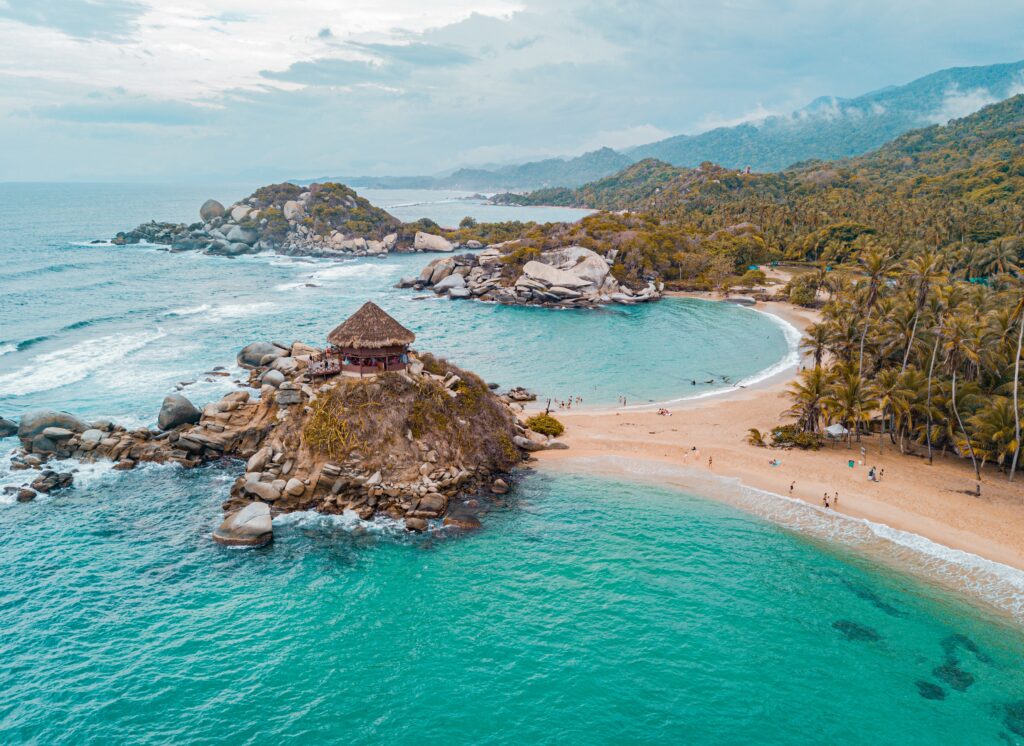
- Colombia is the epicenter of swimwear manufacturers
Colombia has a thriving textile industry so many major swimwear brands (like Maaji and Agua Bendita) are based in Colombia because of this. That being said, if you’re visiting any of the major cities (like Bogota, Medellin, or Barranquilla) this would be the place to shop for swimsuits.
- The Titanoboa fossil was discovered in a coal mine in Colombia
The Titanoboa was the largest snake to ever live (measuring up to 50 feet long) and ruled the Amazon rainforest in prehistoric times. It’s hypothesized by scientists that it must have lived exclusively in marshes and swamps because the massive animal relied on the buoyancy of the water to move its weight around. In 2009, the first fossils of this beast were found in the Cerrejón coal mine boarding Venezuela.
- “Cocaine Hippos” are wreaking havoc on the ecosystem
Invasive hippos are some of the remnants of Pablo Escobar’s reign in Colombia and are expected to eradicate many native species in the next few decades. After Escobar was shot and killed in a military raid in 1993, the four hippos that were illegally imported for his private zoo were released into the wild because there were no zoos or sanctuaries that could take them in. Today, those 4 hippos have turned into almost a hundred and with no natural predators, that number is only expected to increase. Since they are an invasive species, they pose a threat to the native wildlife and plants. Not to mention the danger they are to humans being naturally aggressive and territorial. There’s a big debate on how to solve this man-made problem and many local Colombians argue that they’re good for the economy because many tourists travel to see these hippos which can be found in Guatape, near Medellin.
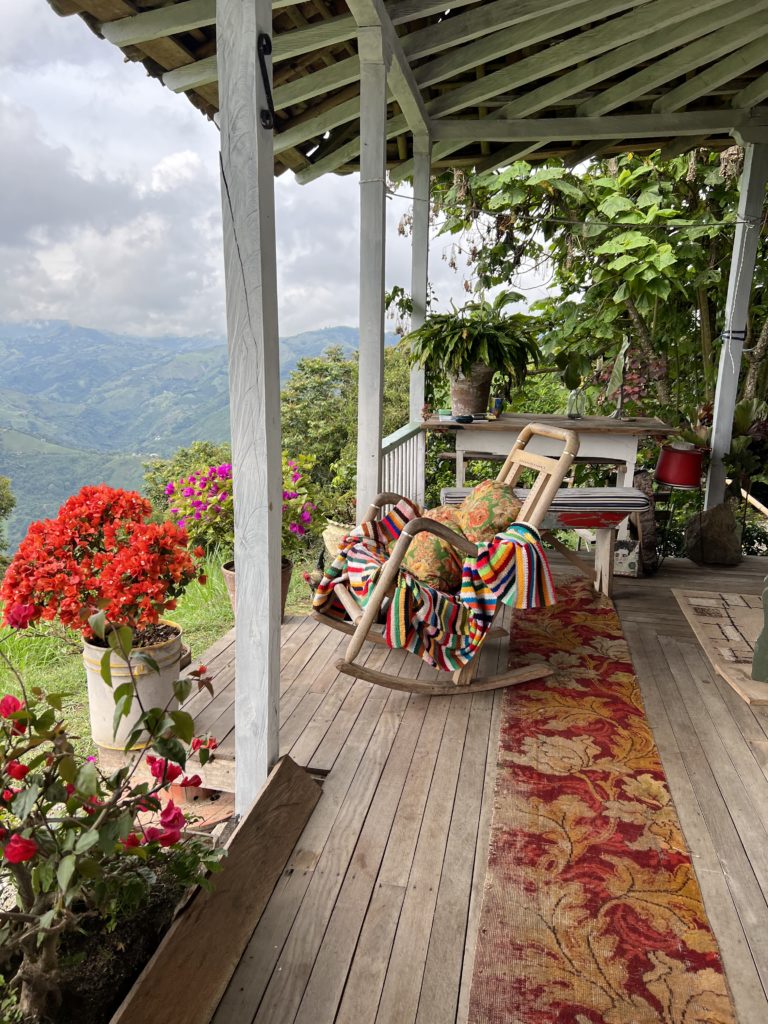
Best Colombia Itinerary for 2 weeks
When I did my research for Colombia, I spent a lot of time sifting through information. Specifically, the best places to see especially if you can only pick a few locations. After my research and first hand experiences, I feel confident that the itinerary I came up with is the very best of Colombia if you have limited time to see the country.
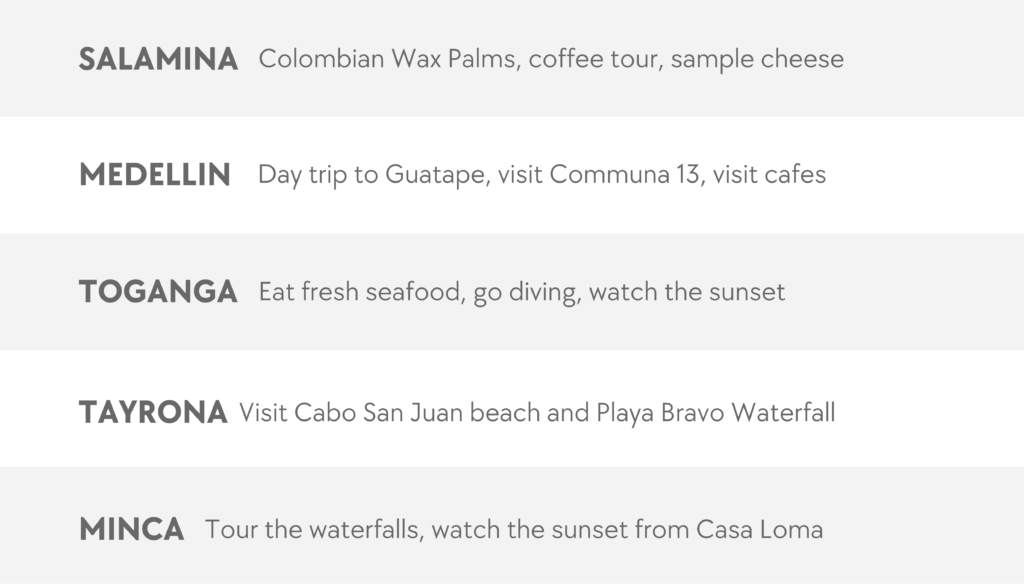
Coffee Axis Colombia
As a major global exporter of coffee, A trip to Colombia is not complete without making a trek to the coffee axis. Even if you’re not into coffee this picturesque region offers rolling green hills, colonial style buildings, and the famous wax palms which you’ve probably seen pictures of. The towns people usually visit within the coffee axis are Jardin and Salento. Valle De Cocora- which is the most popular place to see the wax palms, happens to be sandwiched between them. During my research I discovered the lesser known town of Salamina that didn’t attract as many tourists because it’s harder to reach. There happened to be a smaller valley of wax palms (Samaria Valley) near this town so Salamina seemed like a more desirable option to see the same attractions but in a less crowded way. After visiting Salamina, my instincts were correct and I was very happy with this decision as it wasn’t touristy at all.
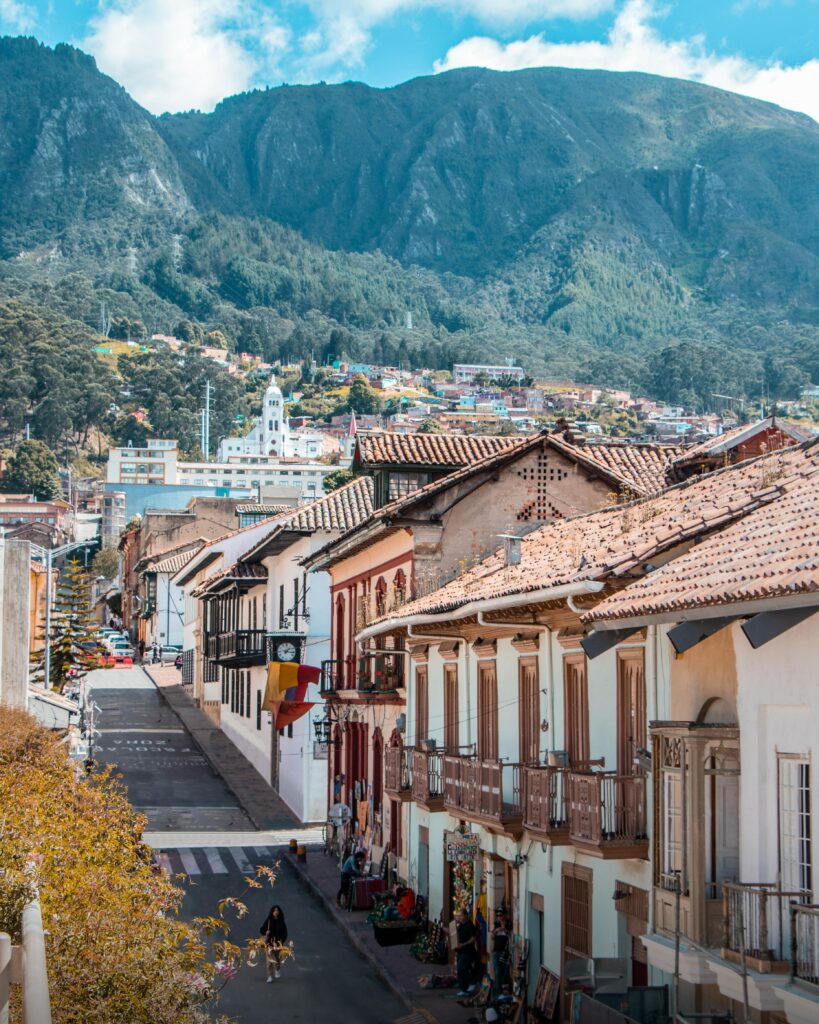
Salamina
Salamina is a tiny town with a tight-knit local community located at the end of a treacherous winding road that ends on the top of a mountain. As you can imagine, the views are incredible with rolling green hills in all directions and misty mountain tops extending further in the distance. Salamina is located near the town of San Felix which is known for its cheese production so you’ll have plenty of opportunities to sample different cheeses when you visit Salamina. San Felix is also the town you drive through on your way to Finca Mirador Del Samaria (where you can visit the wax palms).
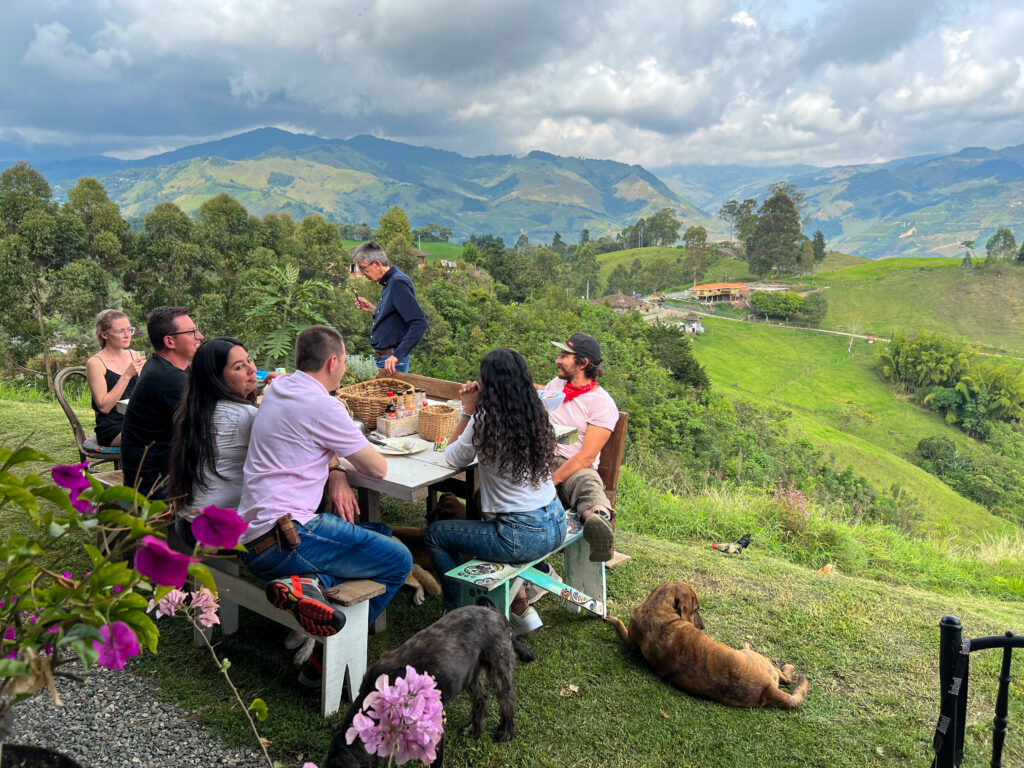
How to get to Salamina
We traveled to Salamina by flying into Pereira from Bogota. Then we took a private taxi all the way from the Pereira airport to the farm in Salamina. Most people travel by bus to get to the farm which is a much cheaper option if you’re on a budget. If you travel by bus you have to change buses in Manizales and then eventually take a private taxi to the farm once you arrive in Salamina. We found this region and the public transportation to be extremely safe, so don’t hesitate to take the bus if safety is a concern. However, whether you choose bus or taxi or bus, be prepared for an intense four hour drive along winding roads.
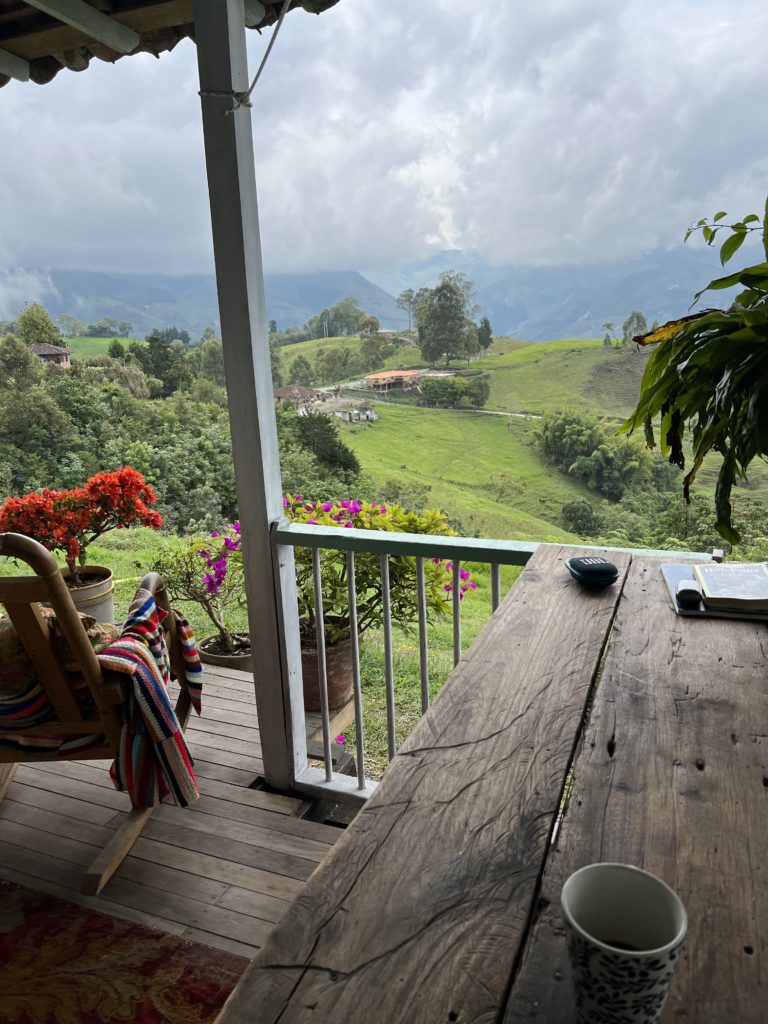
Where to stay in Salamina
I stumbled upon the most incredible hidden gem that is worth going out of your way to stay at: Alto Bonito Salamina. Alto Bonito is a traditional hacienda on a small farm that’s been built by a local Colombian man using all reclaimed materials. The real selling point though is the jaw-dropping views it provides as it sits on the top of a hill displaying postcard-worthy views in all directions. If you’re like me and you have a list of epic places to stay at around the globe, this one needs to make it onto your list. The magic of this place cannot be explained with words, but rather felt- you’ll see what I mean the moment you step foot on the property. This truly was the highlight of our Colombia vacation. Book this rustic rental here.
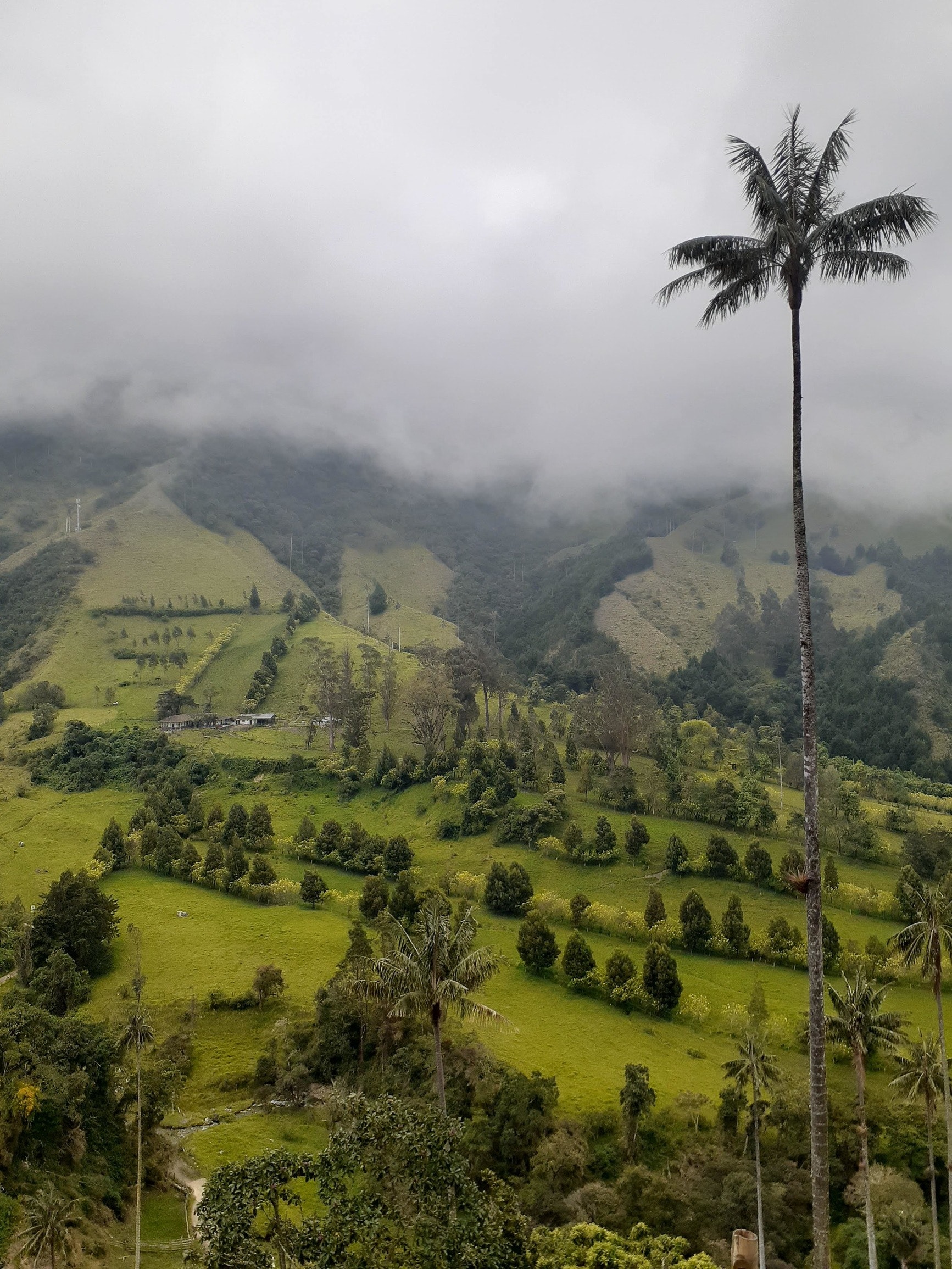
Colombian Palm Trees
There are only a few places in Colombia where the Wax Palms grow, and Colombia is the only place in the world where these palms grow. Until recently (2007), the few places where these palms grew were inaccessible due to these regions being overtaken by guerilla soldiers and cartels. This made the wax palms unable to be studied, but also in turn, protected them from overtourism (a double edged sword). These wax palms are unique and can live for up to 200 years and can reach a height of 200 feet. They’re also the only palm tree in the world that is able to grow in such elevated and cold climates. These palms are critical to the survival of the Yellow Eared Parrot which roosts in the trunks of dead wax palms and eats the berries provided by the living ones. Indigenous tribes once used the wax found on the stems for candle making and the stalks for building materials due to their length and tenacious strength. Today the wax palms found on misty mountain tops are a must-see for photographers, botanists and tourists looking to see Colombia’s iconic national tree up close.
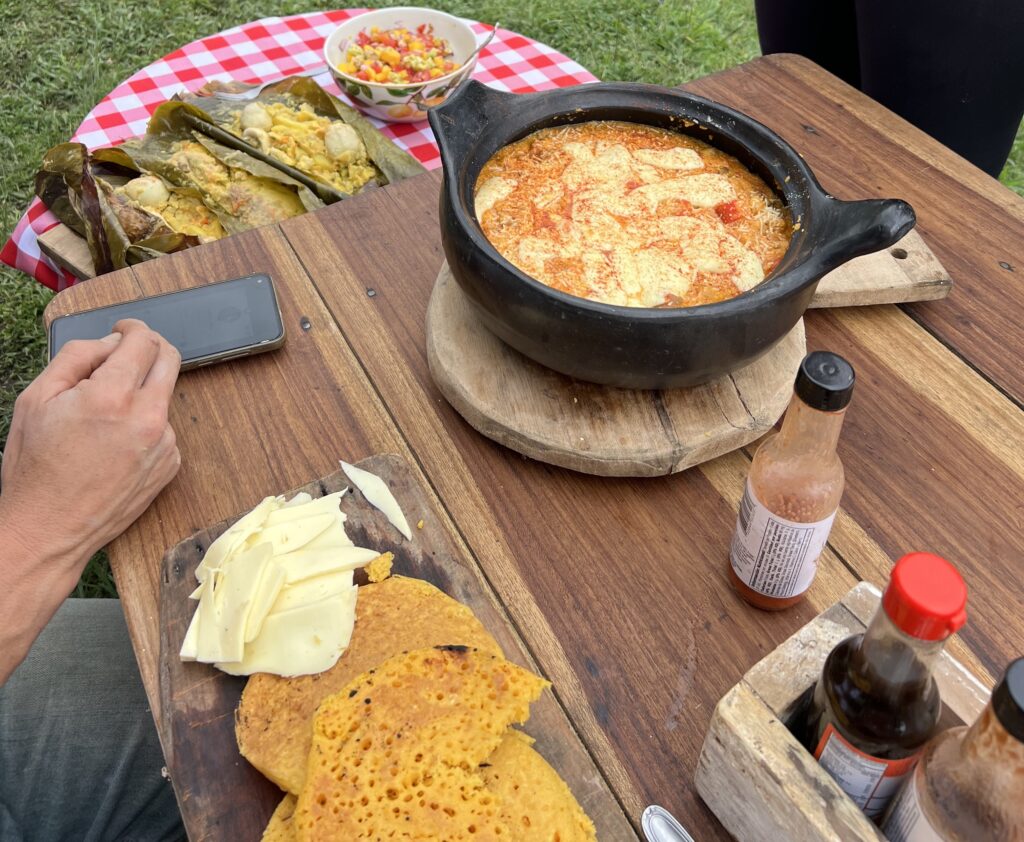
Traditional Colombian Lunch
Because we were in such a non-touristy place, it was very easy to stumble upon authentic Colombian food. Both on the farm cooked by our lovely host, and in the town of Salamina. Pictured above are Arepas (corn tortilla type pancakes), Tamal (eggs and meat cooked in a banana leaf). I also got to try Macana at a cafe in Salamina (biscuit crackers soaked in milk with sugar and cinnamon) which was my favorite Colombian dish of all. You’ll see signs for it all over the town square.
Medellin
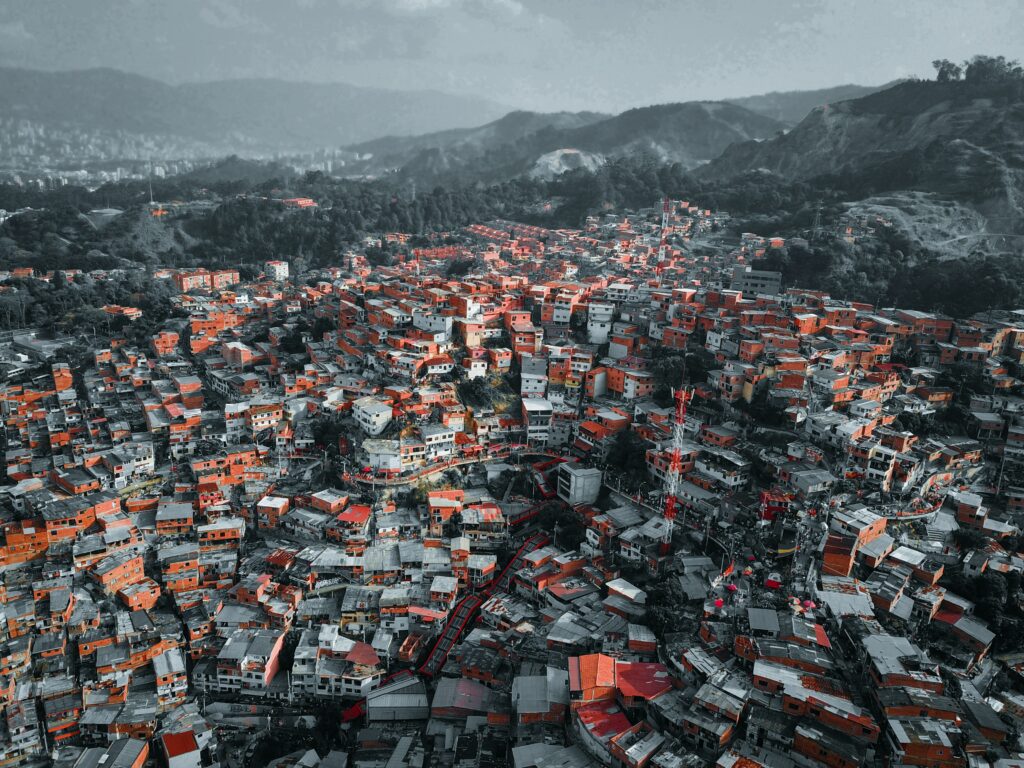
Medellin is scattered across lush rolling hills with entire rivers that run through clusters of buildings. This is a buzzing city full of digital nomads and creative professionals comprised of both local and foreign talent. The nature woven into the city paired with the innovative individuals that occupy this literal concrete jungle reminded me of Ubud, Bali. To top it all off and make Medellin even more spectacular- there is so much to do in this city. Below are a few things to do that are unique to Medellin.
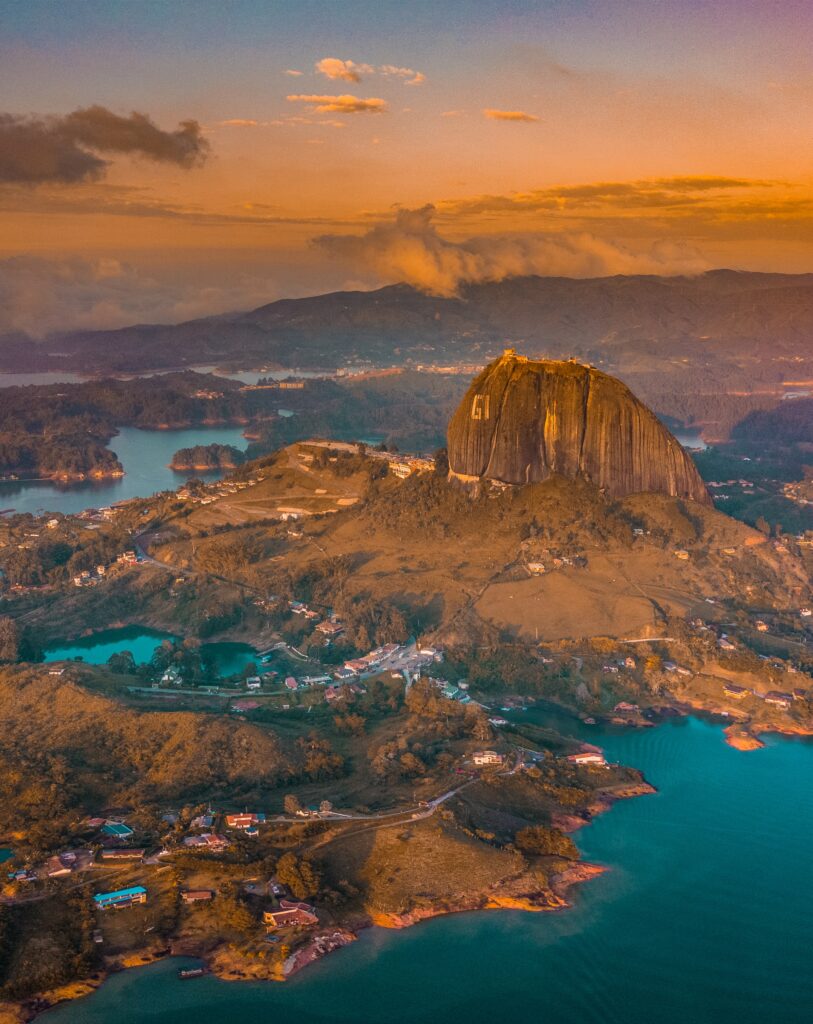
Things to do in Medellin Colombia
- Attend a soccer game
Even if you’re not into sports, attending a soccer game is a must while in Medellin. It can get a little chaotic (which is part of the appeal) so make sure to go with a guide so you can eliminate potential stressful situations by having a local help you buy your tickets and escort you to your seats. Pro-Tip: ou can browse through top rated tours for this on Airbnb experiences.
- Check out the flower market
As I mentioned in the fact section at the beginning of this post, Colombia makes up 15% of the world’s supply of cut flowers so there are tons of the flower stands and markets you can gaze at while in Colombia. One of the biggest flower markets is in Medellin and definitely worth a trip to.
- Check out the cafe scene
Medellin, specifically the Poblado area is renowned for its specialty coffee shops- as it should for a country that makes up 30% of the world’s coffee exports! In Poblado there are tons of swanky coffee shops on every block. It was hard to choose which ones we wanted to experience with such few windows to be caffeinated. My favorites were Cafe Velvet and Azai Praia Lovers.
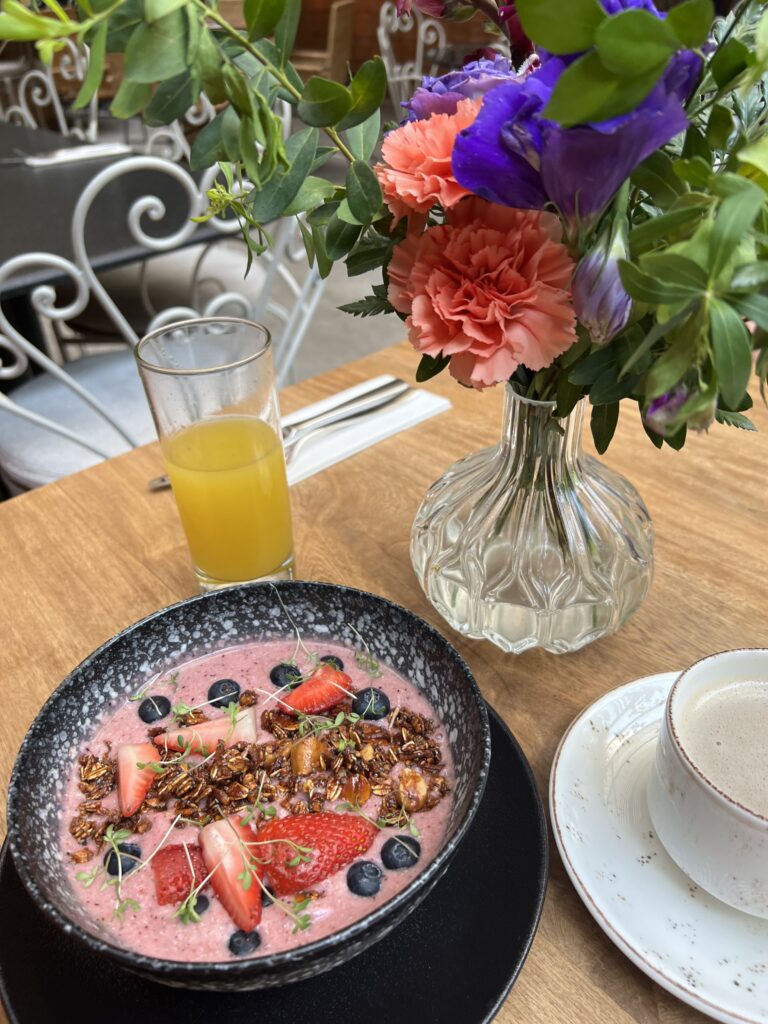
- Visit Makeno
This was one of my favorite things and exactly what I wanted to do while I was in Medellin. Makeno is a boutique containing all locally made products and brands. Everything in this shop was high end and well made. So if you’re looking to support local makers and artists, and buy something unique to Colombia this was the best place I found for this.
- Ride the Cable Car
This not only is a fun way to see the city, you can also easily lump this in with another Medellin “must-see” like Comuna 13 and Park Arvi because you’ll most likely be taking the cable car to get there.
- Visit Comuna 13
Communa 13 used to be controlled by the cartels during Colombia’s violent drug history and during this time was considered the most dangerous neighborhood in the world. After the military raid in 2002, the neighborhood has begun improving alongside the funding the government has invested into making this neighborhood a tourist attraction. Some people feel like Comuna 13 is glamorizing poverty and therefore unethical to visit, however many people who live there are proud to show off their country’s progress towards peace and also benefit from the money generated through tourism.
- Visit Guatape
Guatape is a picturesque lake town located 45 minutes outside of Medellin. Pablo Esobar had mansions here and the remnants can still be toured. This also happens to be the place where his hippos were released after being seized from Escobar’s private zoo of illegally important animals. Other than taking pictures, attending a tour, and shopping for nick-nacks, there’s not much to do in this town other than hike to the top of El Penon De Guatape for a view of the (man-made) lakes.
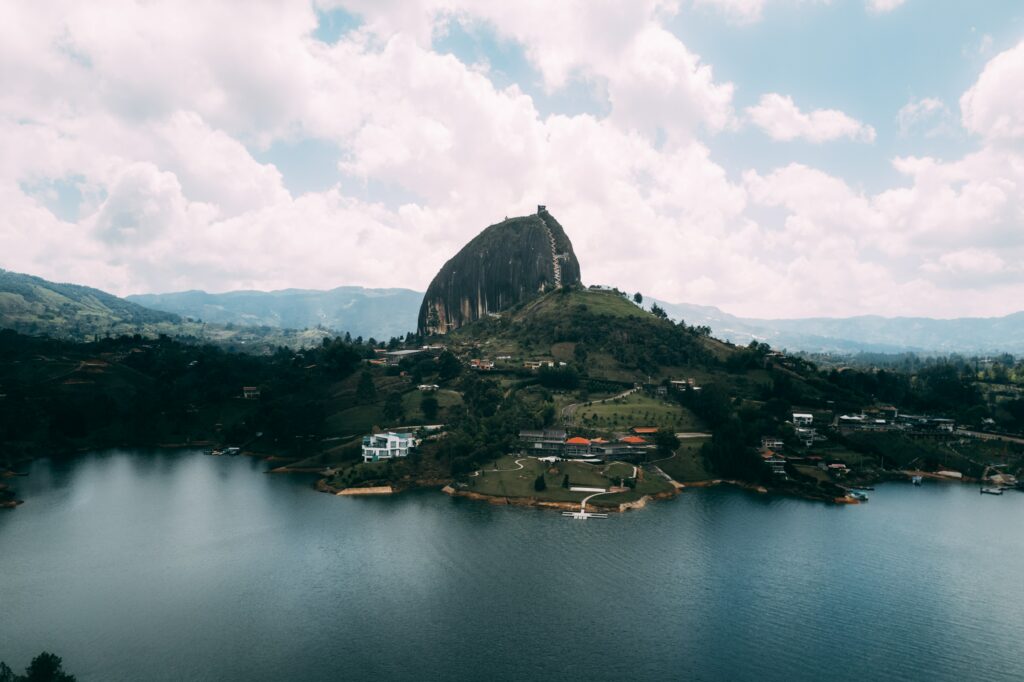
- Hike through Park Arvi
As I mentioned above when I talked about Colombia’s biological diversity, Park Arvi is located outside of Medellin and is a great place to witness that diversity without trekking deep into the jungle. The Park is massive so don’t underestimate the time needed to explore the park. If you’re lucky, you might be able to catch a glimpse of the rare orchids, birds, and butterflies that inhabit this park and the country of Colombia.
- Check out the restaurants
Medellin is such a great scene for foodies. You can find almost anything you want here from sushi to authentic Italian food. A couple restaurants I recommend trying are El Cielo and Carmen.
- Shop for swimsuits
As I said in the facts section, Colombia has a thriving textile industry and because of that they produce the largest supply of swimwear fabrics. They are home to many upscale swimwear companies (like Maaji) so if you need a new swimsuit, Medellin would be the city to do it in. Check out El Tosoro and the Santa Fe Mall to find some of the upscale brands selling their swimwear.
- Go paragliding
If you’ve ever wanted to go paragliding to get a bird’s eye view of a city, this is the city to do it in! Just try to allow a little bit of a buffer schedule-wise because there’s a high chance you will need to reschedule due to rain. Like I said, the city of Medellin is scattered across rolling green hills in the jungle so this would be beautiful to see from above and definitely something to add to your bucket list. Check out Airbnb experiences for top rated guides for this.
- Learn Spanish
Colombia is said to be one of the easiest places to learn Spanish due to the pacing of the dialect and slower speech. There are a lot of places that will get you conversational within a few weeks. Spanish is also pretty important here because most locals don’t speak English.
Where to stay in Medellin
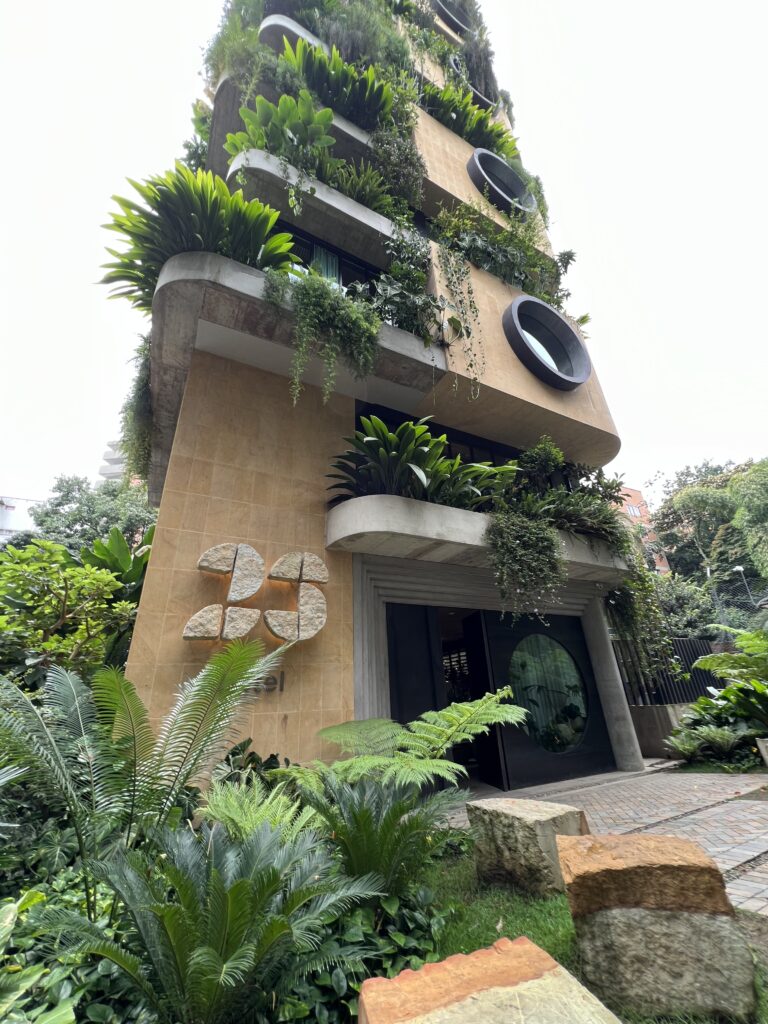
The two most common neighborhoods for travelers to stay are Laurelles and Poblado. Laurelles is more of an expat community and Poblado is the upscale area with all the bars, cafes and high end accommodations.
We stayed at the 23 Hotel in Poblado, which has been on my hotel bucket list for a long time and definitely lived up to the hype. This boutique hotel combines retro and modern amenities with lush gardens strategically placed throughout the exterior of the hotel to offer additional privacy for the floor to ceiling windows found in each room. This hotel was also in walking distance to all of the shops, cafes and bars so it worked out perfectly.
Cafes in Medellin
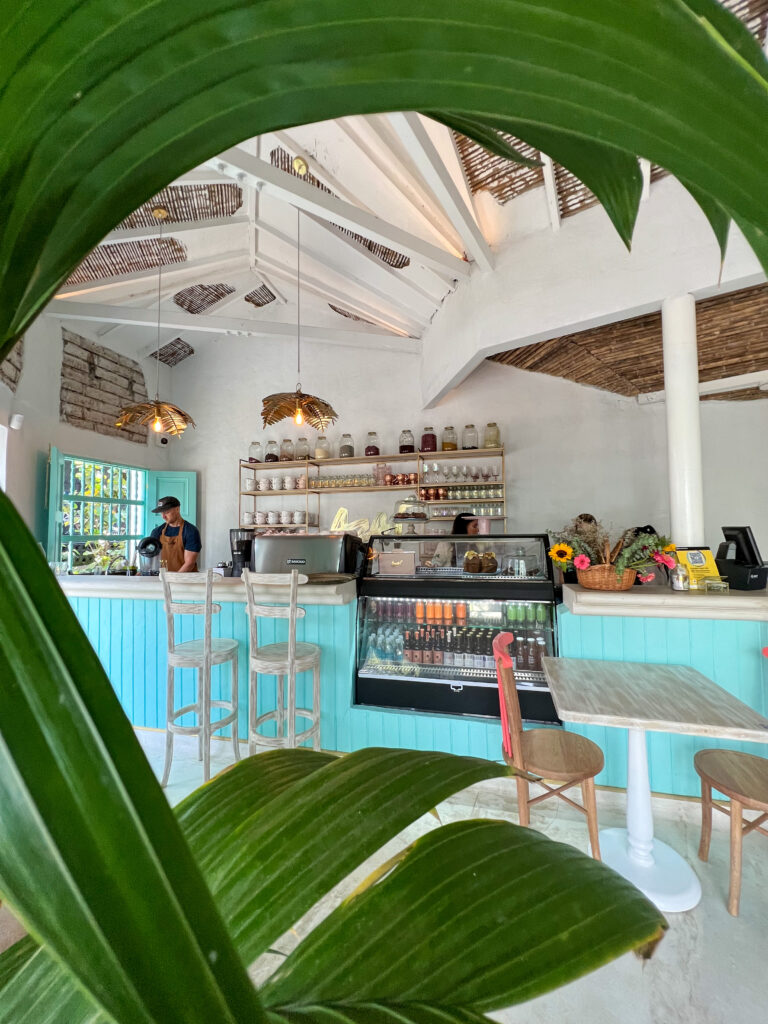
I didn’t get enough time to really check out the cafe scene here unfortunately, so I ended up spending all my cafe time at Azai Praia Lovers because it was so amazing I didn’t want to go anywhere else. They have the best acai bowls and the BEST chicken and waffles I’ve ever had. The decor is also really bright and tropical and reminds me of a trendy cafe you’d find in Bali. Cafe Azai also sits on the edge of a river so I got to see an iguana in the wild one morning while I was having my coffee at the bar. They also have one of the coolest bathrooms I’ve ever seen. Another cafe that I researched and walked by many times was Cafe Velvet, which is supposed to be one of the best coffee shops in Medellin.
Restaurants in Medellin
Carmen and El Cielo are supposed to be the best places to go to experience a true culinary masterpiece. I found that any nice restaurant in Medellin is going to be comparable to the US price-wise so don’t expect to find a fine dining experience for pennies on the dollar, especially in Poblado.
Taganga
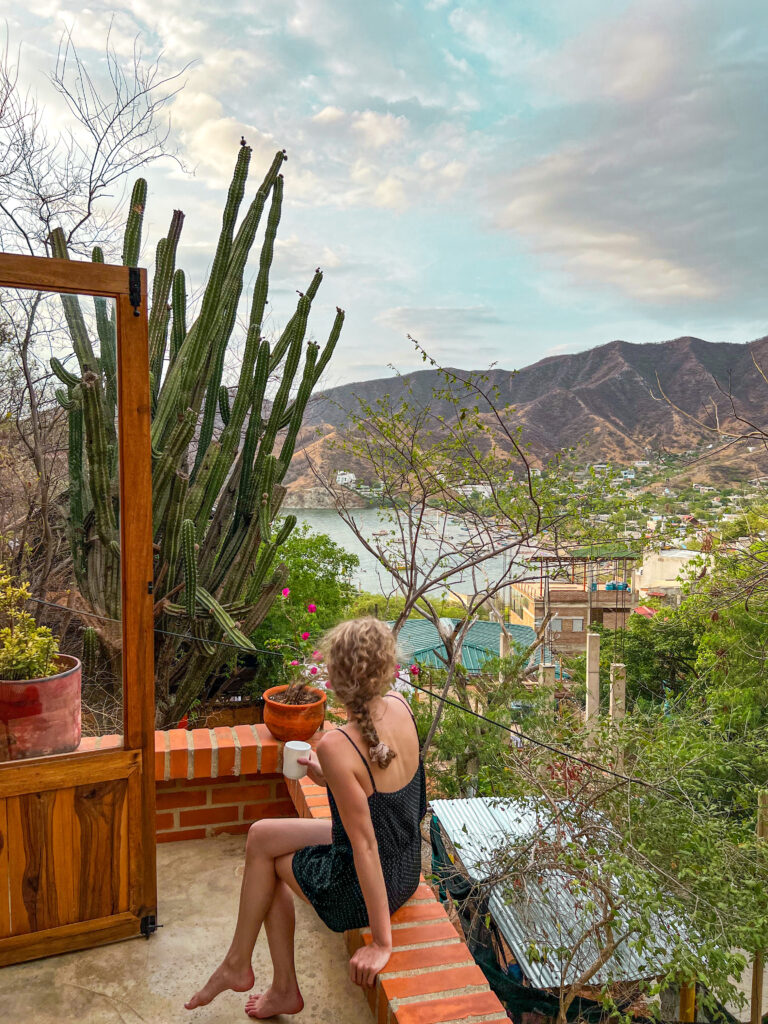
Taganga is a mellow beach town and fishing village located 15 minutes from Santa Marta, which is where we flew into from Medellin. Since it’s on the northern coast, it had a drastically different biome than medellin and the coffee axis. Toganga, despite being on the ocean, was much drier and hotter than the southern regions.
Things to do in Taganga
Get Scuba Certified- Like I mentioned before, Taganga is one of the best places to get dive certified due to the especially calm waters, flourishing ocean life, and low cost of the dive programs.
Try fresh seafood- Since Taganga is a fishing village this is considered one of the best places to try some seafood. Taganga is extremely small so all the best food stands and restaurants are in a line right on the beach. Ask a local for recommendations depending on what you’re looking for.
Where to stay in Toganga
Since Taganga is so picturesque, I really wanted to stay somewhere with a view of the harbor. This was actually pretty hard to find but I guess it’s understandable with how small the town is. I ended up stumbling upon this hidden gem that was everything we were looking for, and only $30/night. It was also created by a local Colombian woman who had renovated the bottom half of her house to host travelers, so being able to directly support a local woman’s venture was a bonus to staying somewhere so gorgeous.
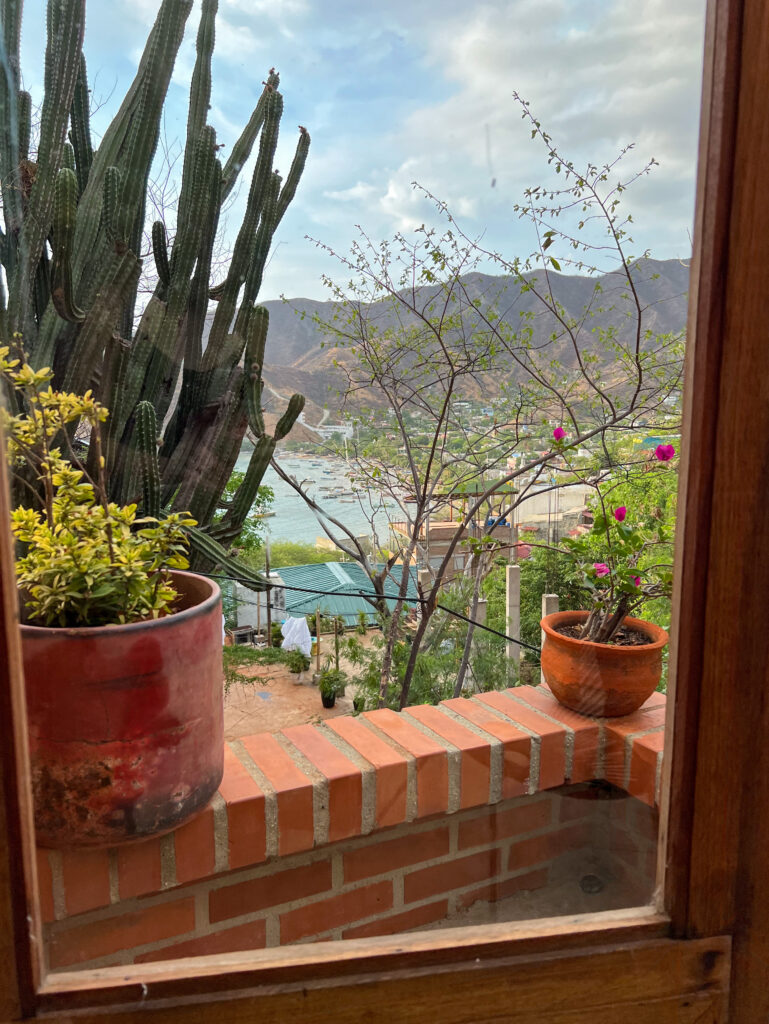
Tayrona National Park
Before arriving in Colombia, I was a little confused about what to expect when it came to visiting Tayrona National Park so hopefully this gives you some clarity.
Tayrona National Park is a protected wildlife conservation as well as a Pueblo where the indigenous people of this region live. There are two main entrances into the park, Calabazo and El Zaino. Which one you enter from will depend on which attractions you plan on seeing, more on this below.
There are hotels and hostels located near each entrance as well as an ATM, which you’ll want to utilize because your entrance fee (and everything purchased within the park) is cash only. There also is no service or wifi within the park.
To get to any of the attractions located within Tayrona National Park will require trekking through the (hot) jungle for a few hours, so make sure you are in appropriate physical shape to tackle this. I’m in pretty good shape and I found it challenging with the heat. You also have the option of hiring a boat from Toganga or Santa Marta to take you by water to one of the beaches if you don’t want to hike in.
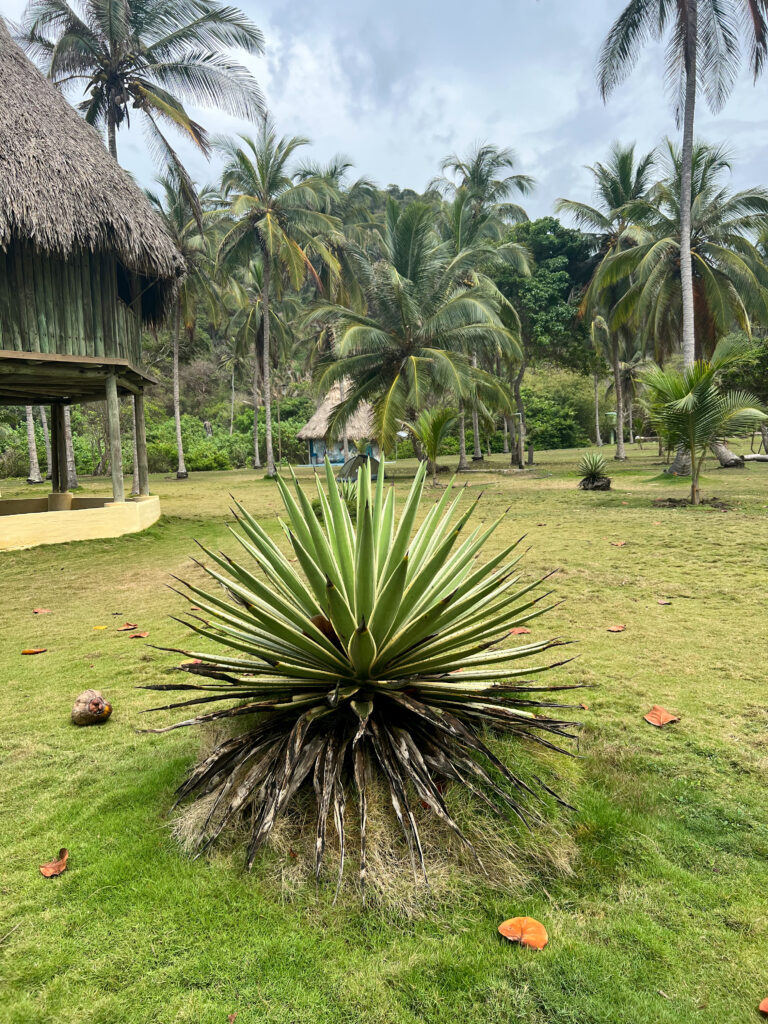
How to get to Tayrona National Park
The closest city is Santa Marta. From there you can take a bus all the way to the entrance for a few dollars or take a private taxi for a higher price. You can also take a bus from Cartagena or Taganga if you’re coming from those areas, but you will pass through Santa Marta to get onto the road that takes you to the park.
How to visit Tayrona National Park
There are two main entrances into the park, Calabazo and El Zaino. A lot of travelers enter from one and exit through the other, doing the trek in a loop and hitting as many of the attractions as possible. El Zaino is by far the busiest entrance and because of this, you’ll need to arrive before 9 am to stake your spot in line. If you arrive at 9 or after, you’ll be waiting for hours just to enter the park, making your trek even hotter. Hiking from the El Zaino entrance is also extremely crowded and you’re hiking on a man-made path. We hiked in and out through Calabazo and only passed a couple people each time. The trek was very secluded and because of this we saw monkeys and other wildlife.
What to do in Tayrona National Park
The main attractions in Tayrona National Park are beaches (the most famous being Cabo San Juan), the pueblo (El Pueblito), and a waterfall (located near Playa Bravo). There’s also a hiking trail for archeology enthusiasts called “9 Piedres” which leads to some unexplained rock carvings.
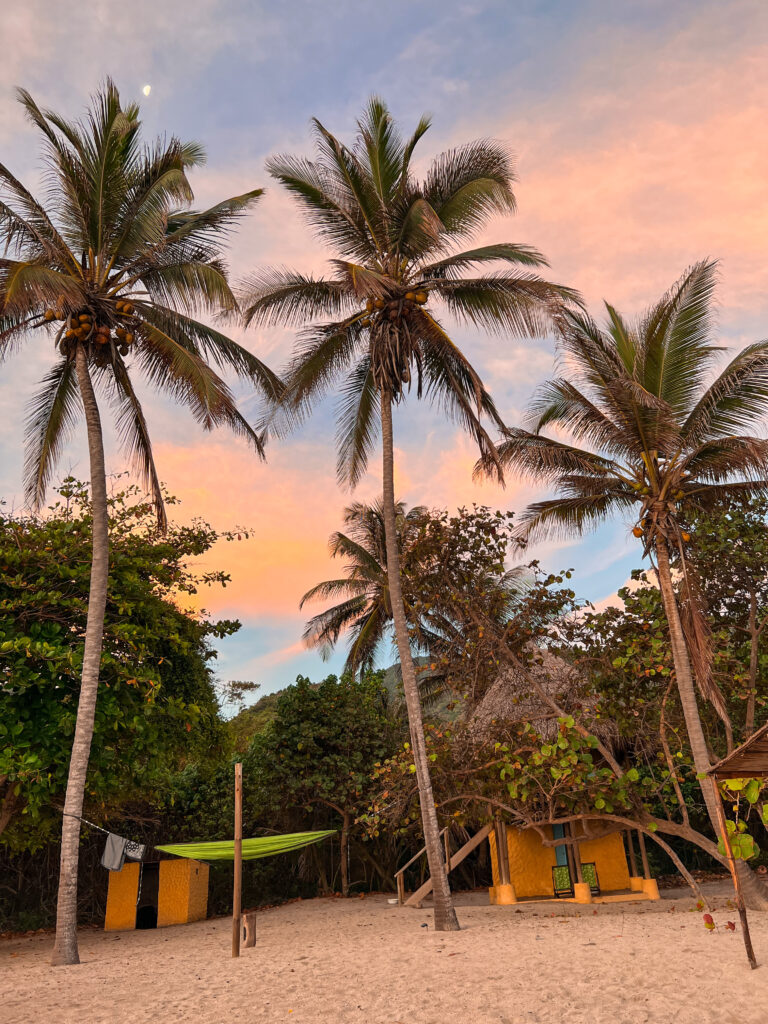
Tayrona National Park Beaches
There are about a dozen beaches to visit in Tayrona National Park (some only accessible by boat) so I’m only going to cover my top 3 picks.
Cabo San Juan
Cabo San Juan is by far the most popular, and most beautiful swimmable beach in Tayrona National Park. If you’ve ever googled “beaches in Colombia”, you’ve surely seen photos of this gorgeous beach. You can rent a hammock and camp at the watchtower (bring a blanket!) which is definitely a bucket list experience, or you can camp near the beach at their designated campground. In order to stay at the watchtower you’ll need to reserve it at the entrance and they sell out quickly so arrive early.
Playa Bravo
Although you cannot swim at Playa Bravo, you do have a beautiful view of the sunset, beachside bungalows to rent (as well as camping options), and an incredible waterfall nearby to hike to. This is where we decided to stay because I didn’t want to be around crowds and I definitely recommend this as an alternative to Cabo San Juan if you also have the goal of escaping the crowds.
La Piscina
La Piscina is one of the few beaches you can swim at and the name translates to “swimming pool” due to its calm and clear waters. This beach does get busy as well but not as busy as Cabo San Juan which would make it an ideal alternative if you want to visit a beach that allows swimming.
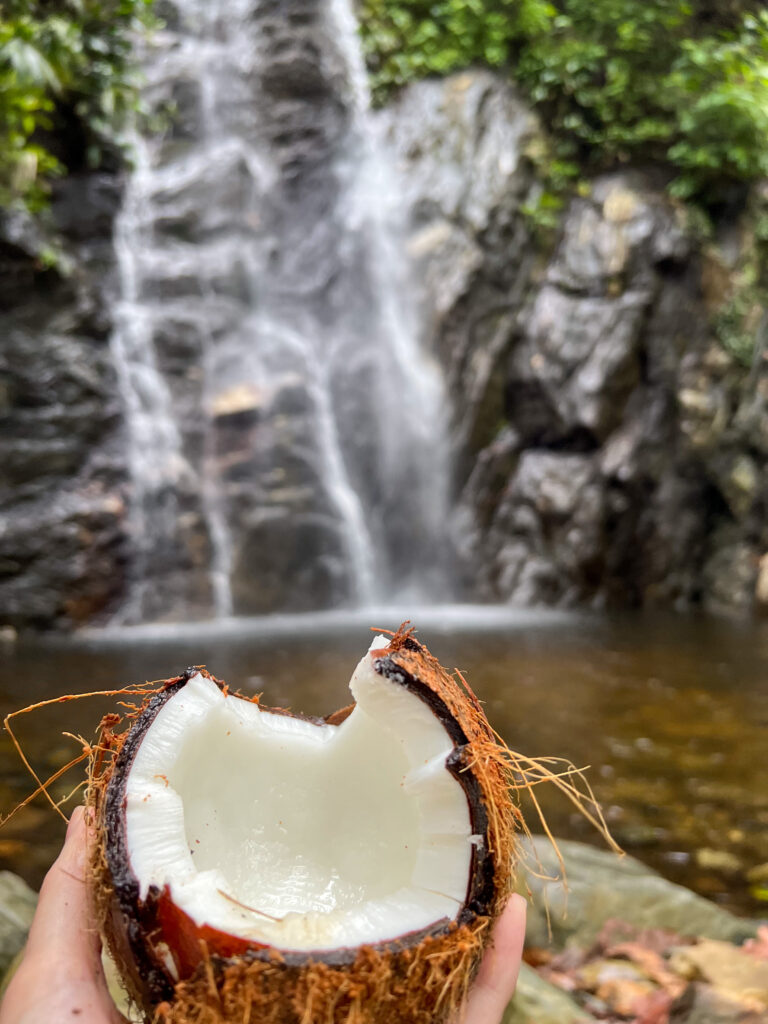
Where to stay in Tayrona National Park
Since most of the attractions require hours of trekking to reach, you will want to make sure you’re staying within the vicinity of the park. When it comes to where to stay in Tayrona National Park, you have 3 options: hotel, hammock rental, or camping. Camping is the most common and will open up a lot more options for you if you don’t mind roughing it. If you want a more comfortable accommodation, you are limited to the only two hotels that are in the park.
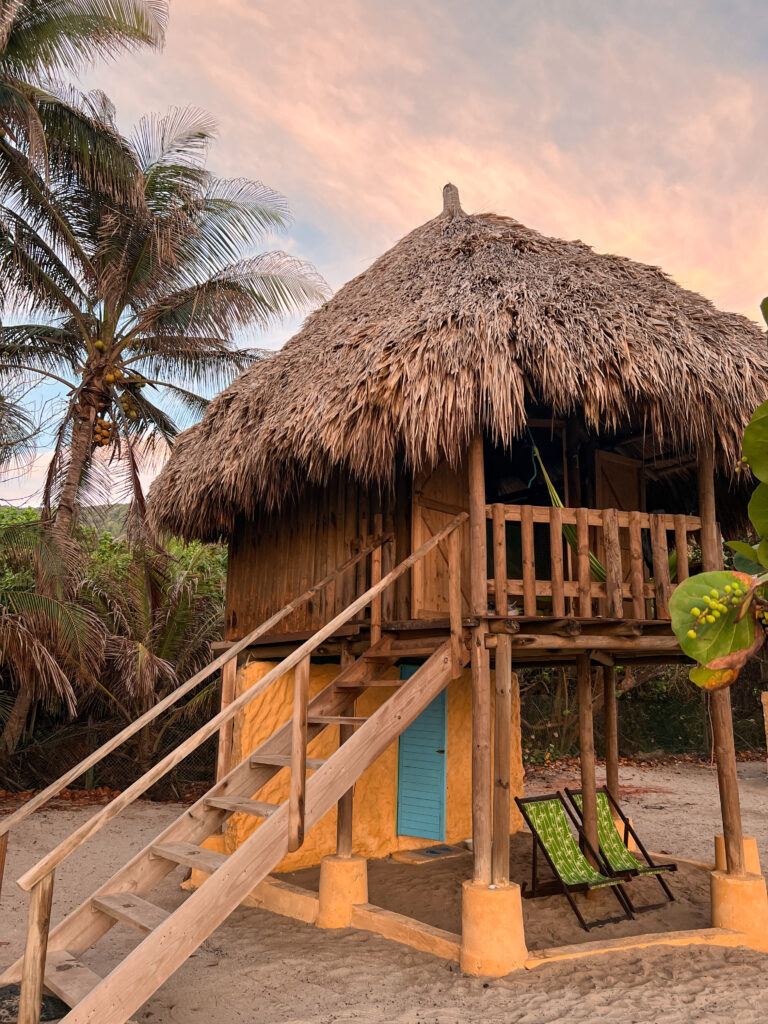
Hotels in Tayrona National Park
When I searched for hotels, many options came up that weren’t actually located in (or sometimes anywhere near) the park. That being said, there are only two hotels in Tayrona National Park that I’m aware of.
The Bungalows at Playa Bravo
The first is a rustic bungalow on the beach in Playa Bravo for $80/night. Although you cannot swim at Playa Bravo, it’s definitely worth making a trip here because this is where you’ll be able to visit the waterfall which is not only a beautiful site but deep enough to swim at.
EcoHabs on Canaveral Beach
The second is more upscale and overlooks Canaveral beach towards the Eastern side of the park (near the El Zaino Entrance) and rents for almost $200/night. If you want the most comfortable accommodation possible, this is the only non-rustic option available in the whole park.
Camping in Tayrona National Park
If you’re prepared to camp, you will have a lot more options when it comes to where to stay in Tayrona National Park. Keep in mind, you will still have to pay a fee for camping on top of your park entry fee. Most campgrounds cannot be reserved in advance and only the day of at the entrance. I also read you can rent a tent at the entrance if you don’t have one which makes camping a little more doable for travelers coming from afar.
Instead of going through each individual campzone, I’m just going to list the places you can camp and you can look at the map of Tayrona National Park to see which campsites are near what attractions and you can form your itinerary from there. You can read this post for more information on campsites.The places that offer camping in Tayrona National Park are: Don Pedro, Cabo San Juan, Castilletes, Arrecifes, Playa Bravo.
Tayrona National Park map
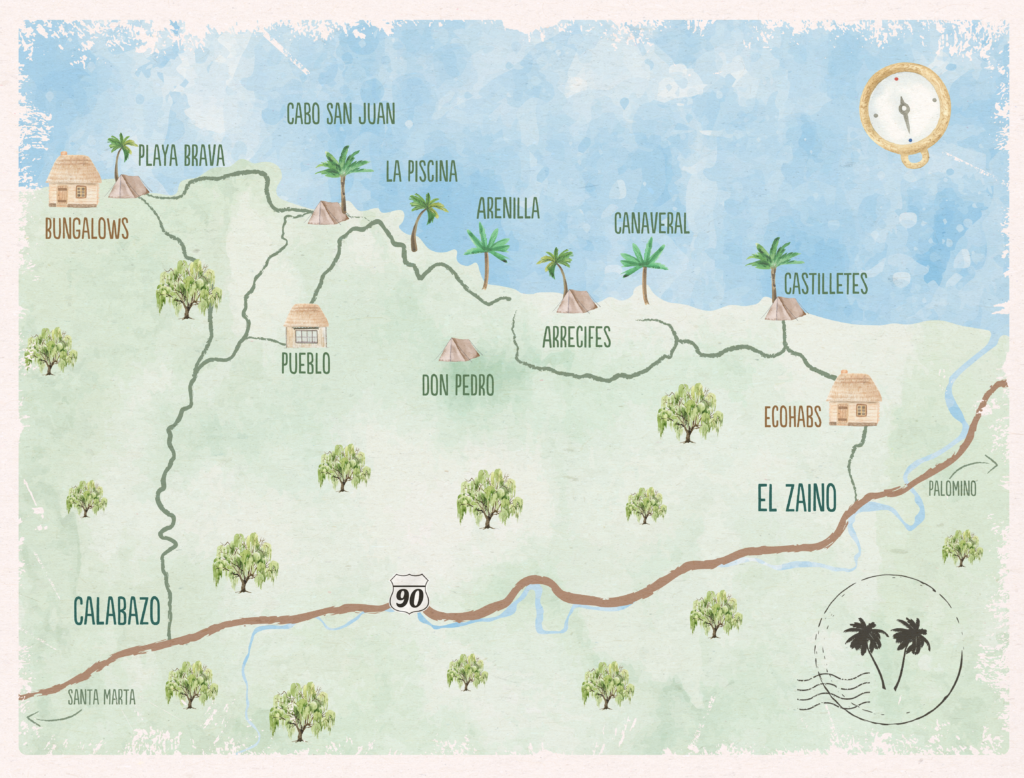
Tayrona National Park Weather
Tayrona National Park gets very hot midday so hiking during cool morning hours is imperative when planning your routes. It also is prone with storms and rainfall so pack some water resistant and warm clothes.
Yellow Fever Tayrona National Park
Many people wonder if you need yellow fever vaccine for Tayrona National Park and the answer is; it is recommended but not required. Santa Marta, Minca and Tayrona National Park are some of the areas where yellow fever (which is carried by mosquitoes) is present. On that note, you might want to pack bug spray for this portion of your trip. I also read you can get vaccinated for this for free in Colombia so this might be worth looking into.
Minca
Minca is located 45 minutes up a windy road and into the jungle from Santa Marta. I was a little disappointed with this town. All the blogs raved about how life-changing this place was and all the travelers we came across urged us to go to Minca. That made me have really high hopes and I was picturing something like Pai, Thailand. Minca was definitely worth checking out for a few days, but it didn’t completely blow me away like I was expecting it to. I think the real appeal of this town is the type of people it attracts. It’s definitely a hub for alternative thinkers where you’ll find a 420-friendly atmosphere and lots of vegan cafes. As for the actual place, there are some waterfalls and some great spots to watch the sunset with views all the way to the ocean.
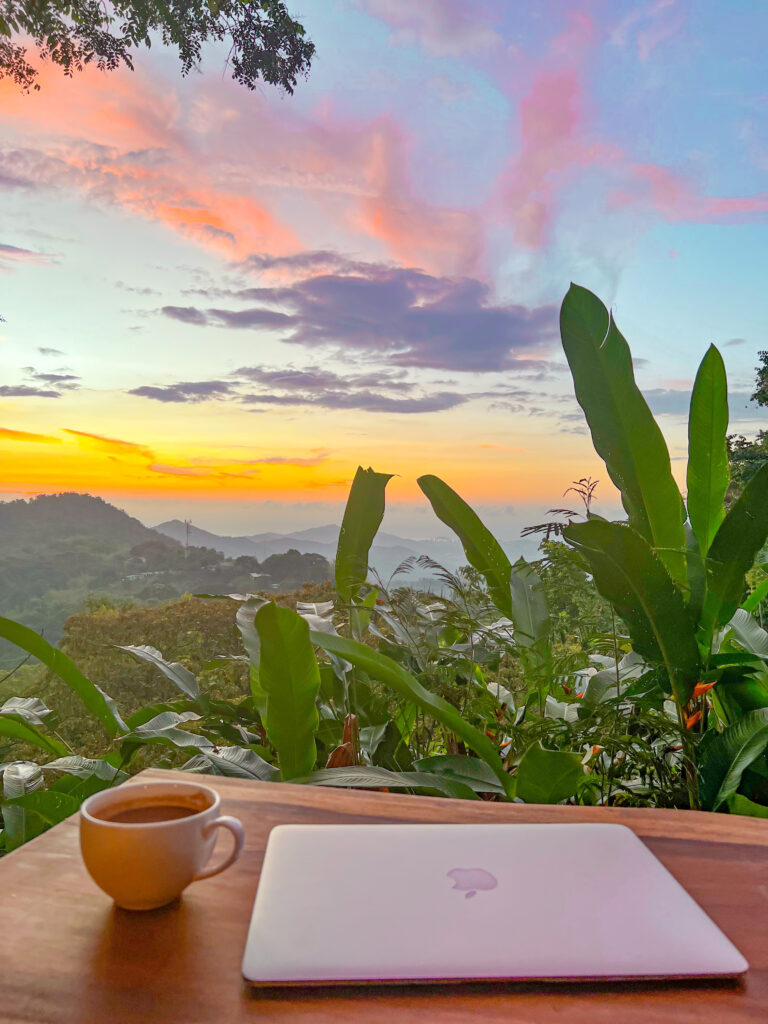
What to do in Minca Colombia
Visit the waterfalls– Minca is the perfect place to chase waterfalls because this town has four to offer and not all of them are easy to find. Pozo Azul is free to enter however it is the busiest, so plan your visit in the early morning to avoid crowds. Marinka waterfalls are really nice but crowded and there is an entrance fee. Cascada Escondida is less crowded and a little more difficult to find. Oido Del Mundo (ear of the world) was my favorite and also the hardest to find because there’s no signage. If you are lucky enough to find it, be aware this is a spot where the locals go and be respectful of that. Read more about the waterfalls in Minca.
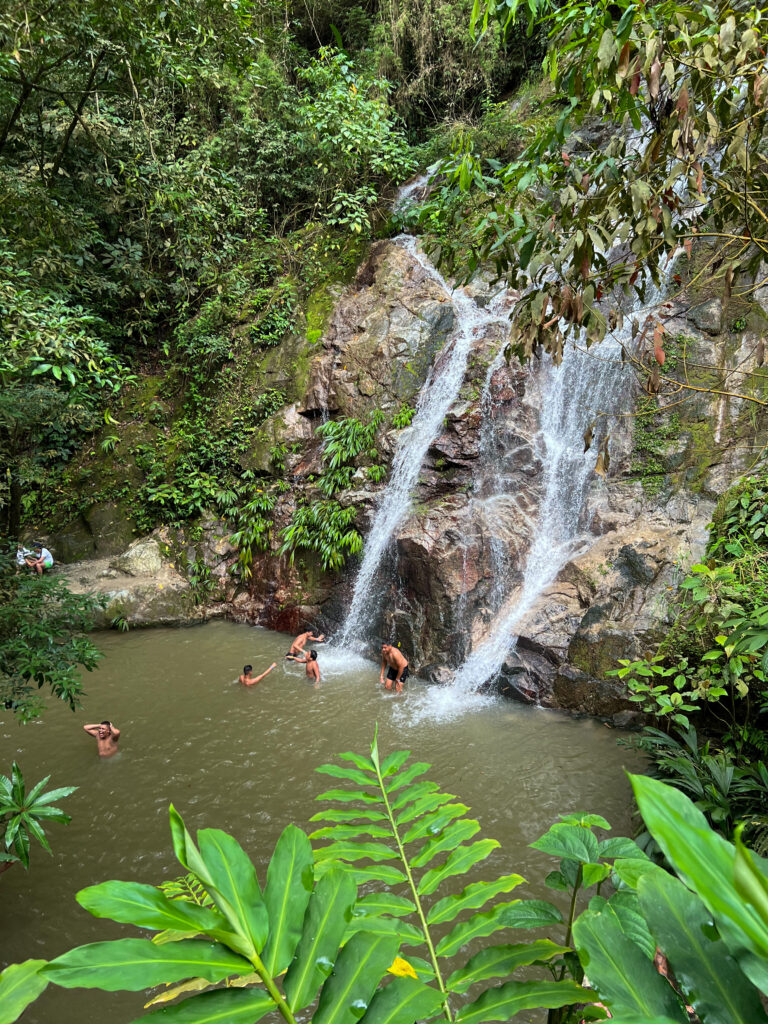
Eat at The Lazy Cat– The Lazy Cat is the best restaurant in Minca and one of the few that offer meat options. The restaurant at Casa Loma is also pretty good but it’s all vegan.
Watch the sunset at Casa Loma– Casa Loma is one of the best spots to watch the sunset from, but prepare yourself for a steep hike. From Casa Loma you can order a drink (try a Maracuya smoothie or hot cacao for an authentic jungle treat) and watch the sunset over the ocean and the city of Santa Marta.
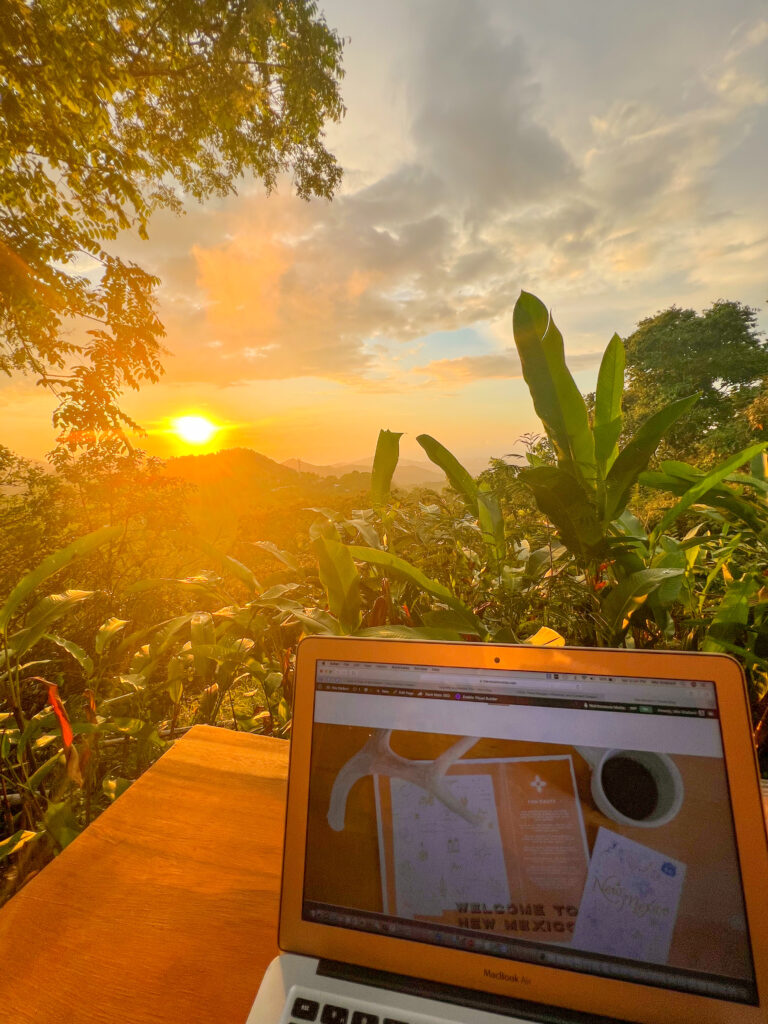
Go Birdwatching- This isn’t my cup of tea, but Minca is considered one of the best places in Colombia to go birdwatching… if you’re into that sort of thing. You’ll see stands along the main road with excursion options if you wish to go on a guided birdwatch.
Try the best vegan ice cream– Whether you’re a vegan or not, Minca has some vegan eats worth a try. Waira Ice Cream & Specialty Coffee Being one of them. They had some interesting flavors like hibiscus, lavender, and Chai. It’s also located past the turn off for Casa Loma and on the way to the waterfalls making it the perfect stop or meeting point before your jungle adventure.
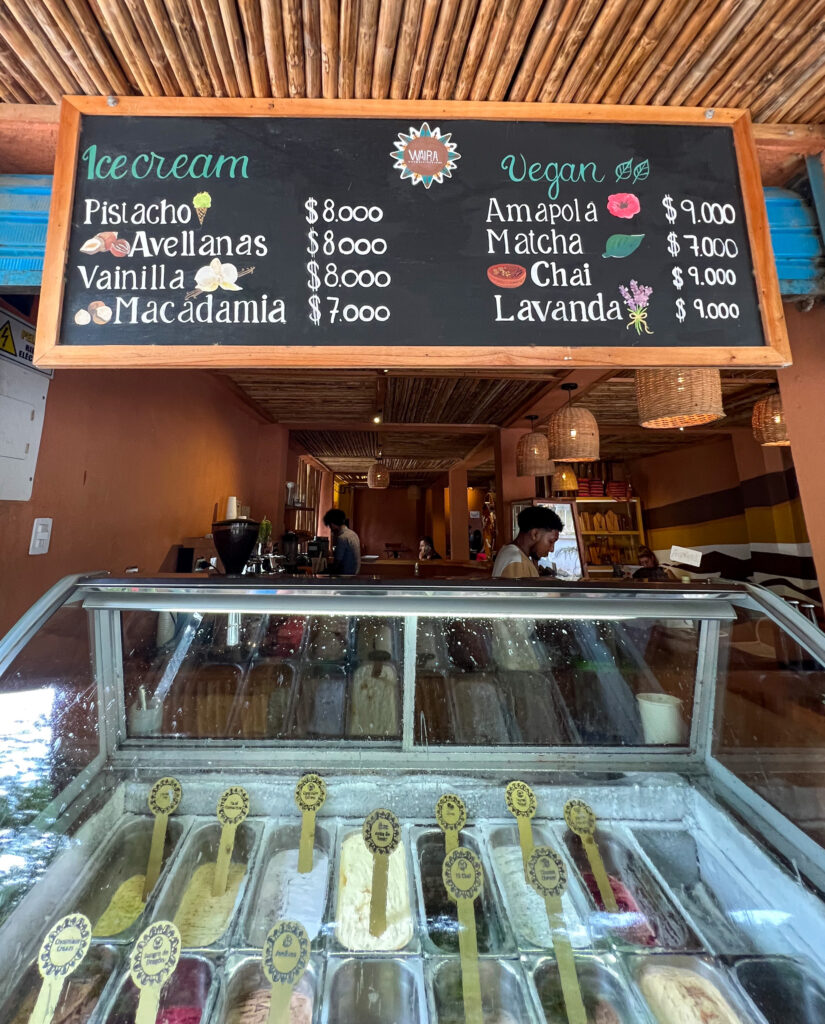
Try Artisan Bread- I actually never tried the fresh baked bread (that you apparently can’t miss because the smell is so intoxicating as you walk by) but this was listed in all the blogs I read about Minca leading up to my trip. So if you’re a bread person this might be a quirky item you add to your Minca itinerary.
Do a coffee tour (maybe)- Minca is actually not located in the coffee axis despite offering a multitude of coffee farm tours. Since Colombia is known for its coffee and therefore attracts related tourism, you’ll find tours in pretty much all the towns and cities, regardless of their association to the coffee axis. To be clear, the coffee axis where the coffee is actually grown and processed so if you’re going to do any coffee related tours, it would be most authentic to do them in the actual coffee axis (Salamina, Salento, Jardin). However, if your itinerary doesn’t allow a visit to the coffee axis, I would think Minca would be a good second option if Colombian coffee is interesting to you.
Where to stay in Minca Colombia
I first stayed at Casa Loma because everything I read mentioned this being the spot. Casa Loma has a good restaurant so people hike up there (yes, hike) to eat and watch the sunset. Casa Loma also hosts yoga classes and other community events so this is kind of the spot and a great place to meet other travelers. I would definitely recommend staying there if you’re traveling solo. However, it was a little too rustic for what I was desiring at that leg of the trip, especially after just coming from a luxury hotel in Medellin. That, with the spotty wifi made me seek another accommodation for our last couple of nights.
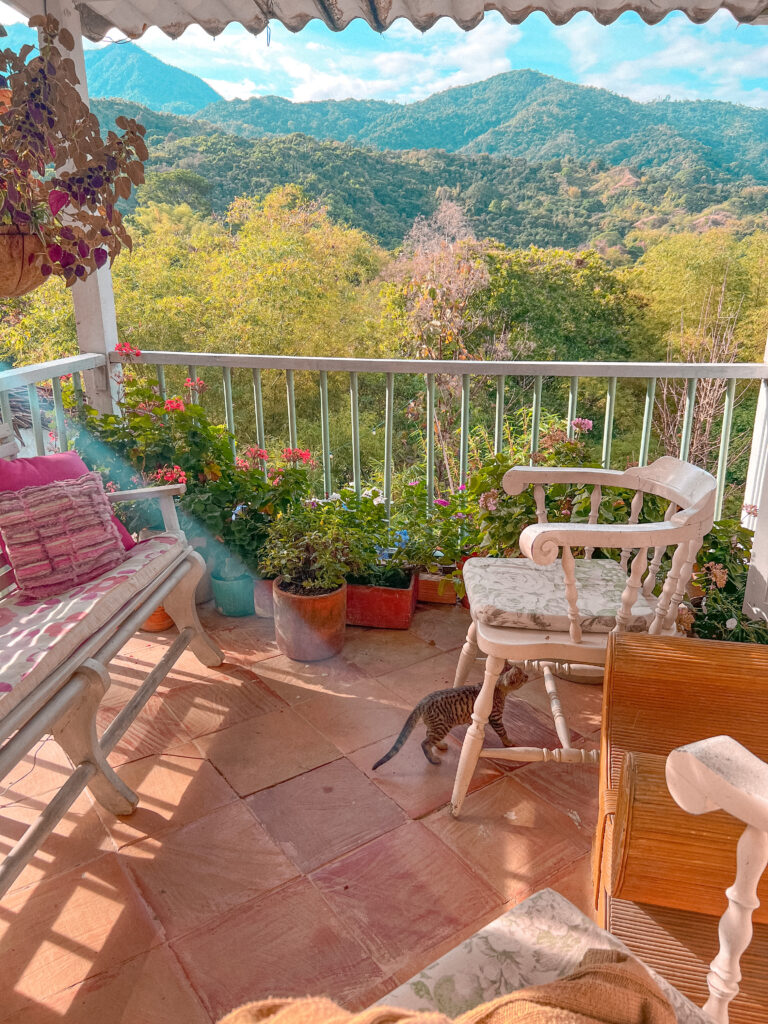
I ended up at a bed and breakfast style airbnb and wish I would have been staying there the whole time. It was designed and created by a local Colombian interior designer and it was really close to the center of town, without an incline. The wifi was also the best I had been able to find there.
Another place to stay with beautiful views and supposedly good wifi is Casas Viejas with their iconic swimming pool and endless views of the Sierra Nevada mountains. It also has been rumored the best view in Minca can be experienced on the toilet at Casa Viejo.
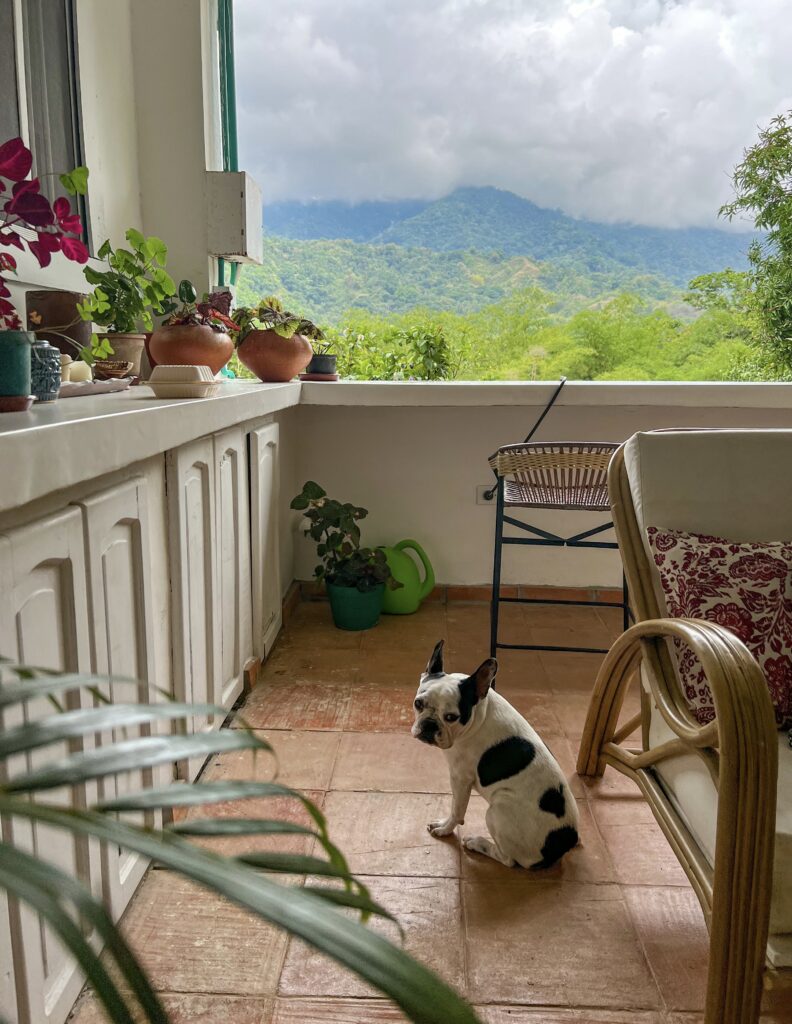
Weather in Minca Colombia
Due to the elevation, Minca is much cooler and more humid than Taganga or Santa Marta. That said, it also rains much more than the coastal towns so come prepared with a warm jacket, shoes that can traverse mud and a poncho.
Things to know about traveling to Colombia for vacation
Getting around
Renting a car- It is not recommended to rent a car here. Your best options are bus, taxi, and plane.
Plane– Even though a lot of places look close together on a map, the terrain is very hilly so it will take way longer to get from place to place than it appears. This is why a lot of people opt for flying. You can fly almost anywhere within the country for about $40-$50. Make sure to look for flights through a domestic airline website like Vivo (not a third party one like Kayak) to get the best ticket prices.
Bus– If you have the time and are on a budget, buses are by far the cheapest way of traveling, costing you usually only a few dollars. Keep in mind though, what will cost you $40 and 1 hour to fly, will cost you a few bucks and 10 hours of travel time. So you’ll have to decide what’s more important to you: time or money. We found traveling by bus to be very safe and a good way to see the country but we chose to fly most of the time due to convenience.
Taxi– Taxis can be a little more comfortable if you’re not excited to travel by bus and experience all the chaos that comes with that. I found taxi drivers in Colombia to be very honest when it came to prices so I wouldn’t be too worried about getting ripped off. It’s still good to ask another traveler what you can expect to pay for your route, plus double check that price with the app Rome2Rio as well as the local app for taxis (Cabify) to get a solid idea of what a fair price is. You can even order your taxi through Cabify but we didn’t really feel the need to do that and instead just used the app to cross check prices. Make sure you’re very clear with your taxi driver when it comes to agreeing on a price and make sure to double check that it is the price for all people in the taxi. Sometimes drivers will give you a price and then once you get to the destination they’ll hit you with the “that’s the per person price”. I always pay my driver immediately after agreeing on a price (not when we get to the destination) so these sorts of… misunderstandings can’t happen.
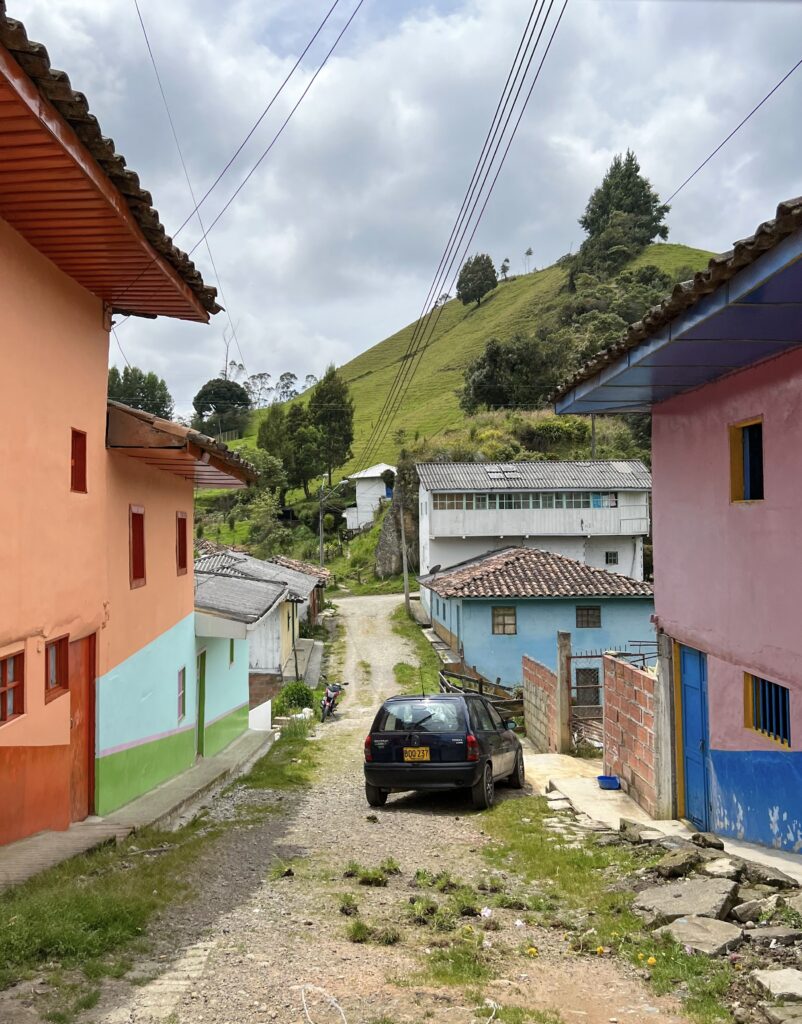
Knowing Spanish
It’s a good idea to brush up on your Spanish before traveling to Colombia because most locals don’t speak English. You’ll be fine if you don’t know Spanish but it will help you tremendously if you do. I also believe this may be why we were never ripped off, the clearer communication you’re able to have thanks to speaking the language, the less room there is for misunderstandings to occur and the more you’re respected by locals. I don’t know that much Spanish but the Spanish I did know helped a ton. I also found Colombia the perfect place to practice Spanish because the language is spoken much slower and clearer here and the locals were very patient.
Avoiding Scams
Other than what I mentioned about discussing prices with taxi drivers (which applies no matter where you are in the world) I didn’t experience any scams in Colombia. We did get haggled a lot while in Medellin. Many people approached us with some sort of gut wrenching story that ended in why they needed money. It’s a personal decision on whether or not you feel like giving money and I think either decision is ok. However I will say, Poblado is the upscale area in Medellin and where all the wealthy people and travelers go, and people know that. So while I think some people are in genuine need of help, I think others are doing big business. I only say this because I’ve worked as a busker in upscale places like this with lots of foot traffic and I saw first hand the amount of money that changes hands. Lastly, I’ve heard there are tons of scams in Cartagena due to the amount of tourism there. This video was really helpful in identifying those scams.
Talking about Pablo Escobar
Pablo Escobar is a controversial and divisive issue. While some Colombians are grateful for the infrastructure he funded, others have lost family members due to the violence he instigated and therefore despise him. I can’t imagine how angering it would be to have been personally impacted by his reign of violence and then hear tourists talking about him as though he’s a God. Unfortunately that is the reality as this country does attract “dark tourism” by those morbidly curious about the country’s history with drugs and violence. So out of respect for the locals and your own safety, avoid talking openly about Pablo Escobar.
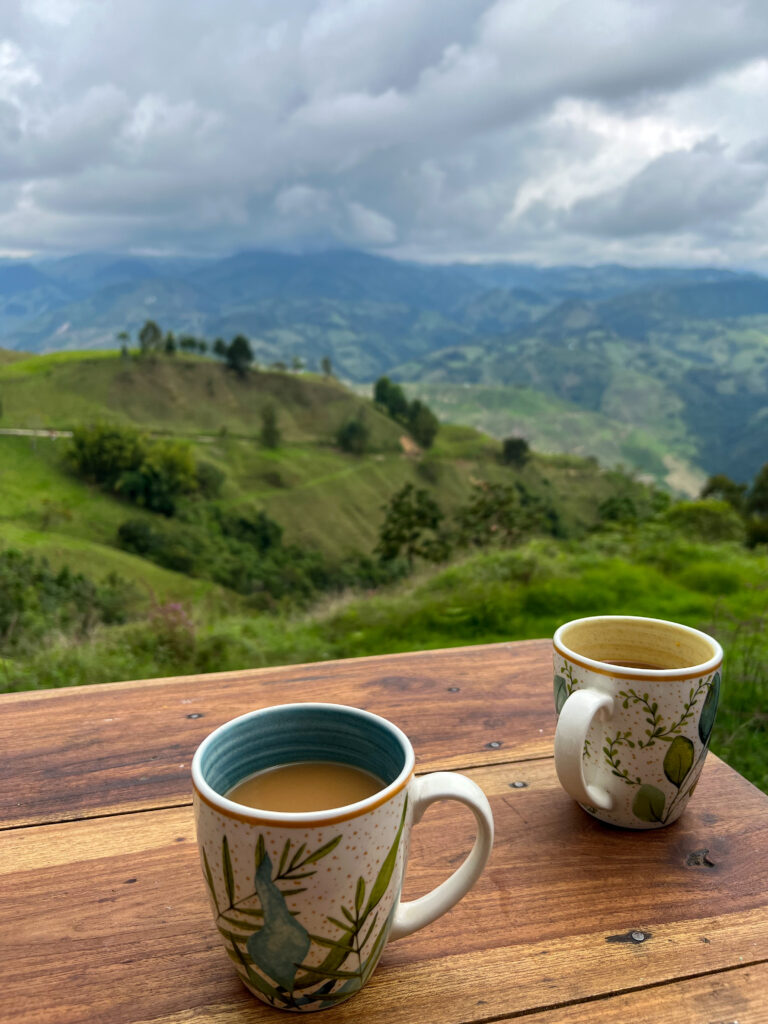
Frequently Asked Questions
What is Colombian Peso to USD?
$3,700 Colombian pesos (COP) equals $1 USD (as of May 2022)As a point of reference, most meals cost us about $25,000-$50,000 pesos which is about $7-$12 US dollars and we ate at fairly nice places and definitely splurged. The cheapest meal we had was at a market in Santa Marta and was an entire plate of food: chicken, rice, beans, and some type of salad for $2.50 (USD) so it’s definitely possible to eat much cheaper than we did, depending on the area. That being said, Colombia is cheaper than the US but not as cheap as SE Asia. If you’re staying in resorts and traveling in that bubble you can easily spend just as much as the US if not more. Alternatively, you could travel Colombia very cheaply but it would take some skill and comfort sacrifices. Traveling to Colombia and within the country is definitely not as easy to do cheaply as it is in Thailand or Bali.
What is the weather in Colombia like?
The rainy season is from April to November but it’s important to remember because Colombia has such a diverse biome, temperatures can range drastically depending on the region. In the coffee axis and other mountainous areas of higher elevation, it can get surprisingly cold. In other areas like the coastal towns, it can be extremely dry and hot. It’s important to remember how large this country is and research the specific location you’re going to in order to be best prepared for your trip.
What are the best times to travel to Colombia?
The most popular times to travel are said to be December to March and June to September. However, I always think it’s best to travel on the shoulder of peak and low season. Not only is it less crowded and cheaper, but it’s also more environmentally conscious because you’re allowing the ecosystem more time to regenerate by not being a part of the stampede.
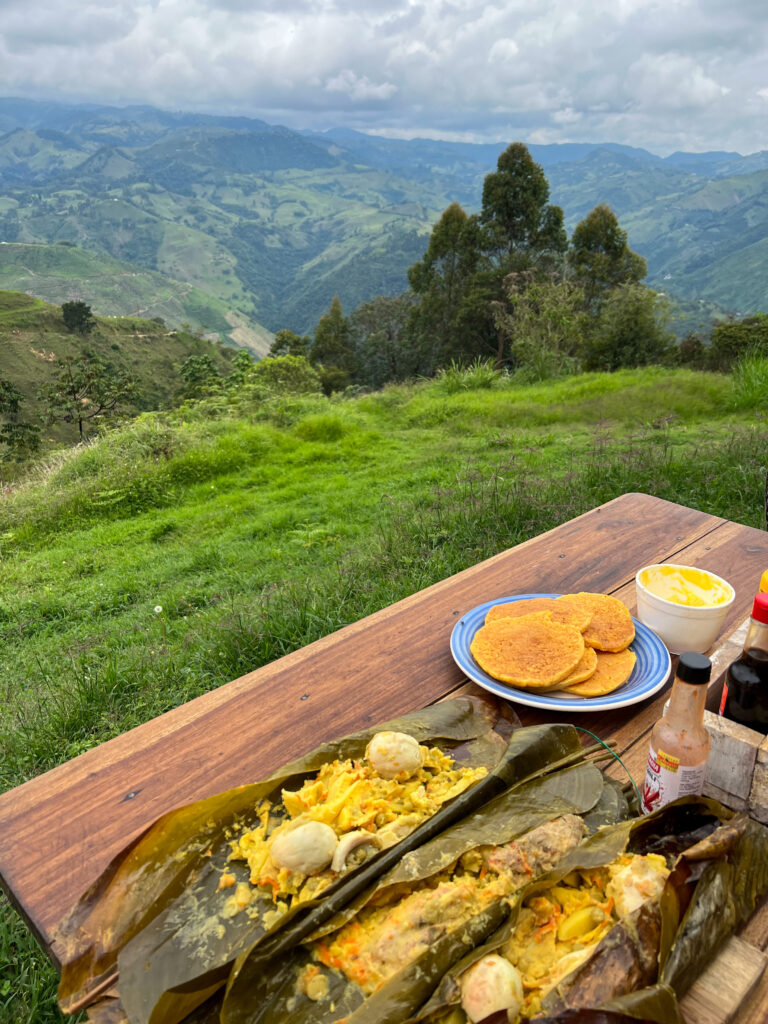
How do I Pack for Colombia for vacation?
A rain jacket and hiking boots are a must. Also make sure to pack a warm outfit if you’re going to the colder areas with high elevation. There are a lot of mosquitos so bring bug spray. A LARQ bottle is a must to conveniently purify your water with UV light on the go.
Can you drink the water in Colombia?
It is safe to drink the water in most areas of Colombia, with Santa Marta and Toganga being the exception. I’m still very cautious when I travel and avoid ice and purify my drinking water even in the areas where it’s supposedly ok to drink the water. I recently invested in a LARQ bottle and purifying my water on the go has never been easier.
Is Colombia safe?
Colombia is very safe. Statistically Bogota and Cali have the highest crime rate but it’s still possible to travel those areas without any issues and many travelers do. Phone snatchings are the most common crime in Colombia so be careful when taking out your phone in crowded public places, especially in Medellin. Twenty years ago Colombia was the kidnapping capital of the world but kidnapping rates have dropped by 93% in the last twenty years. That goes for most of the notorious crimes in Colombia, almost all have exponentially dropped off in recent years and Colombia is now considered safer than many places in the US.
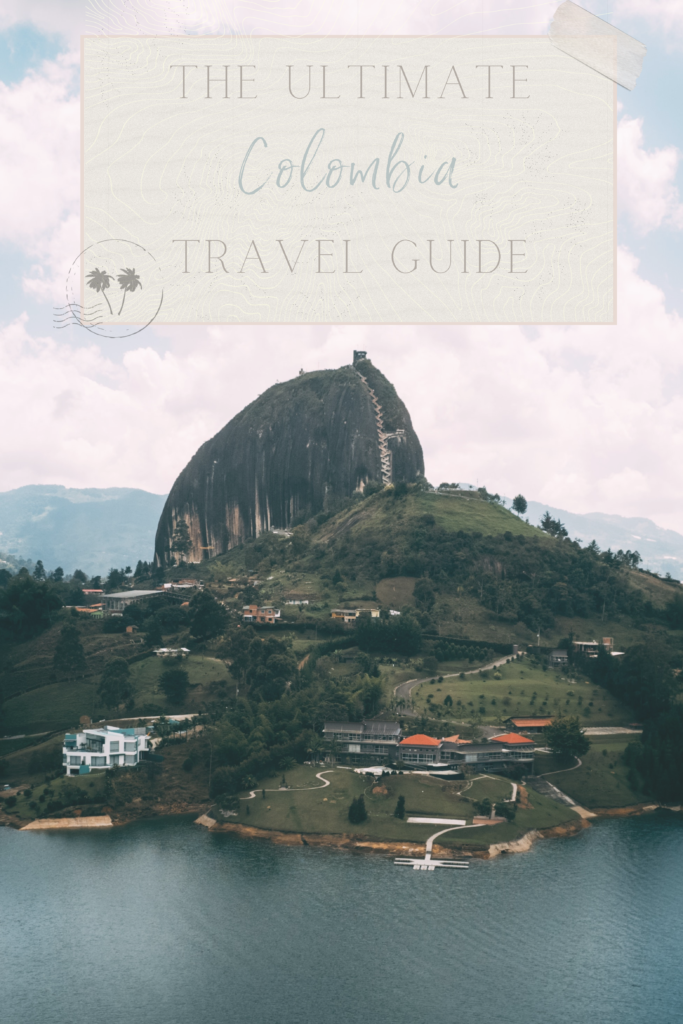
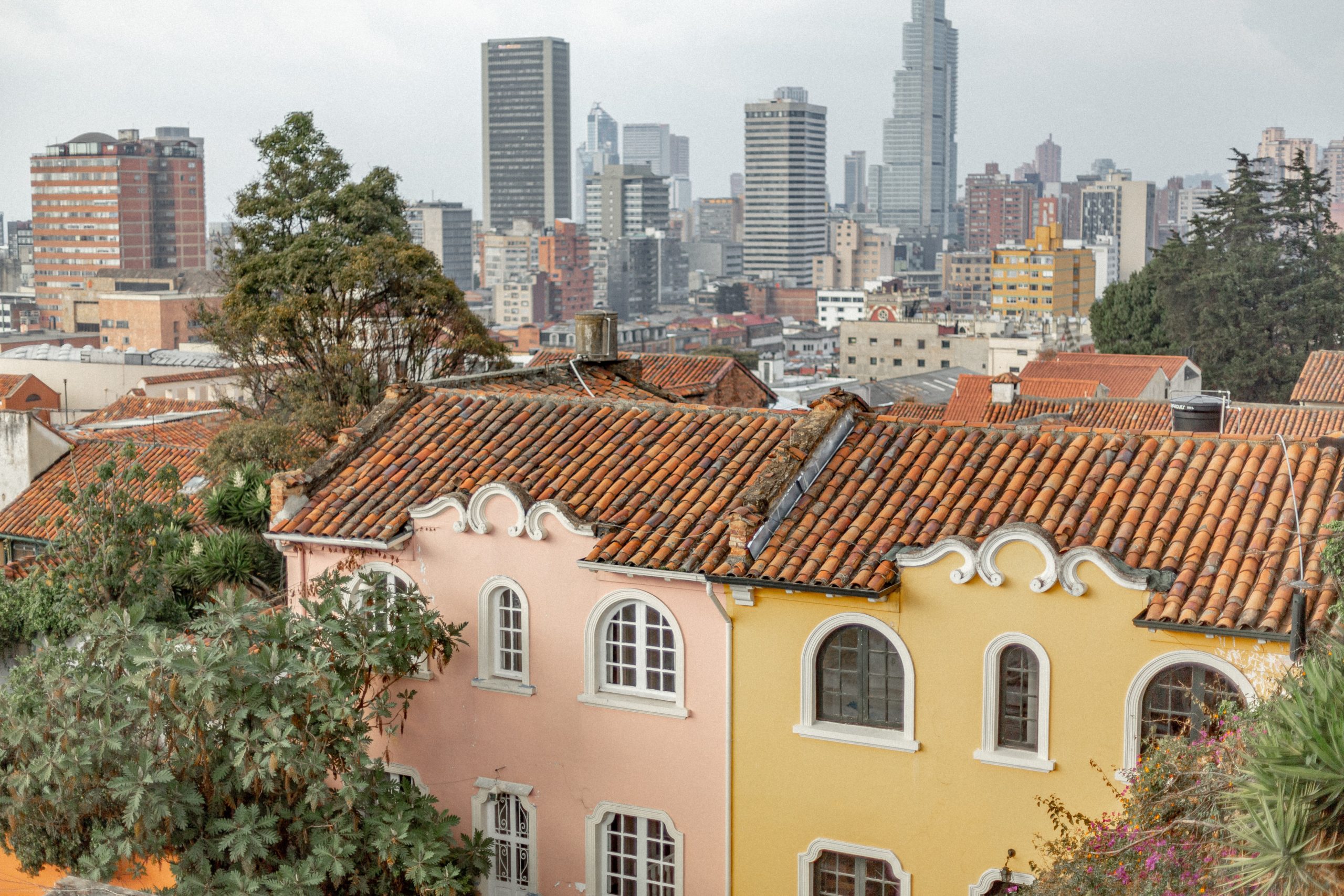

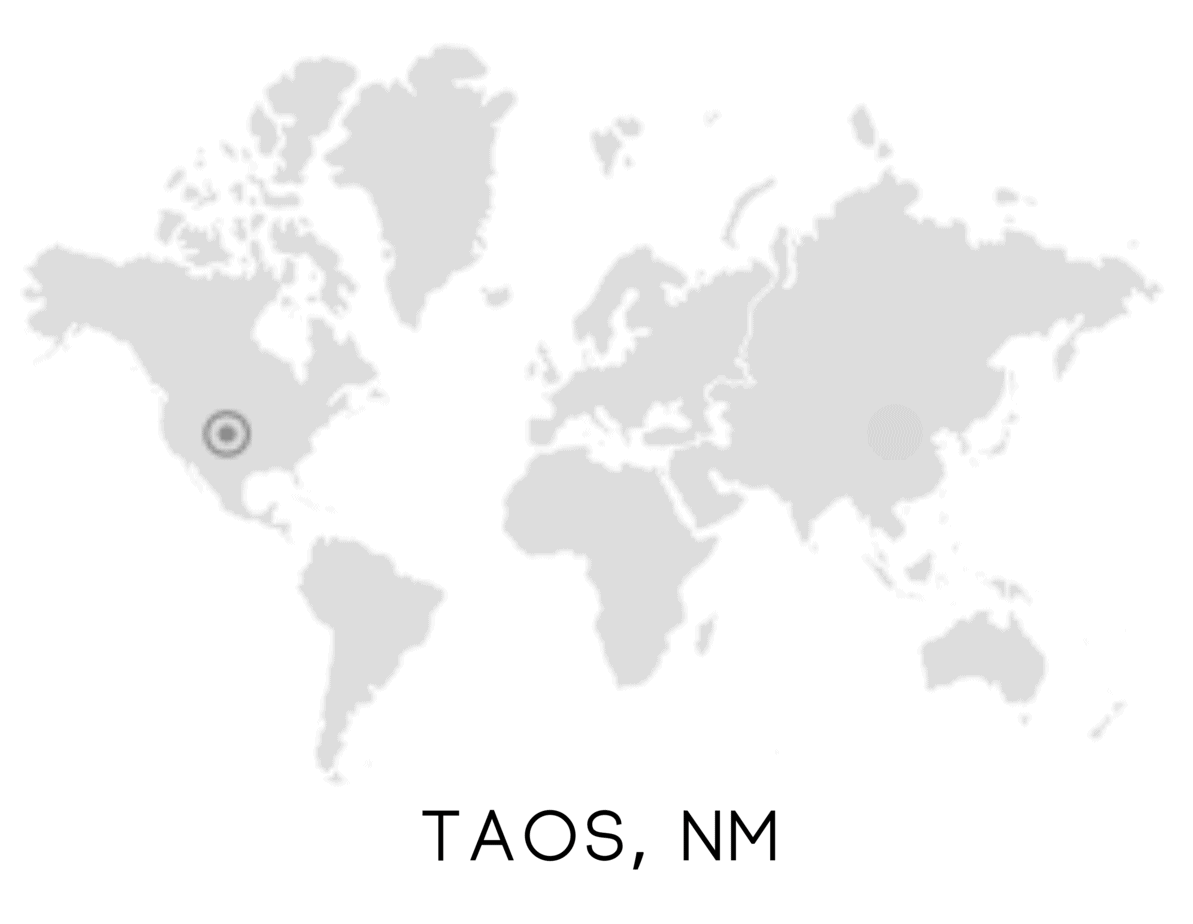
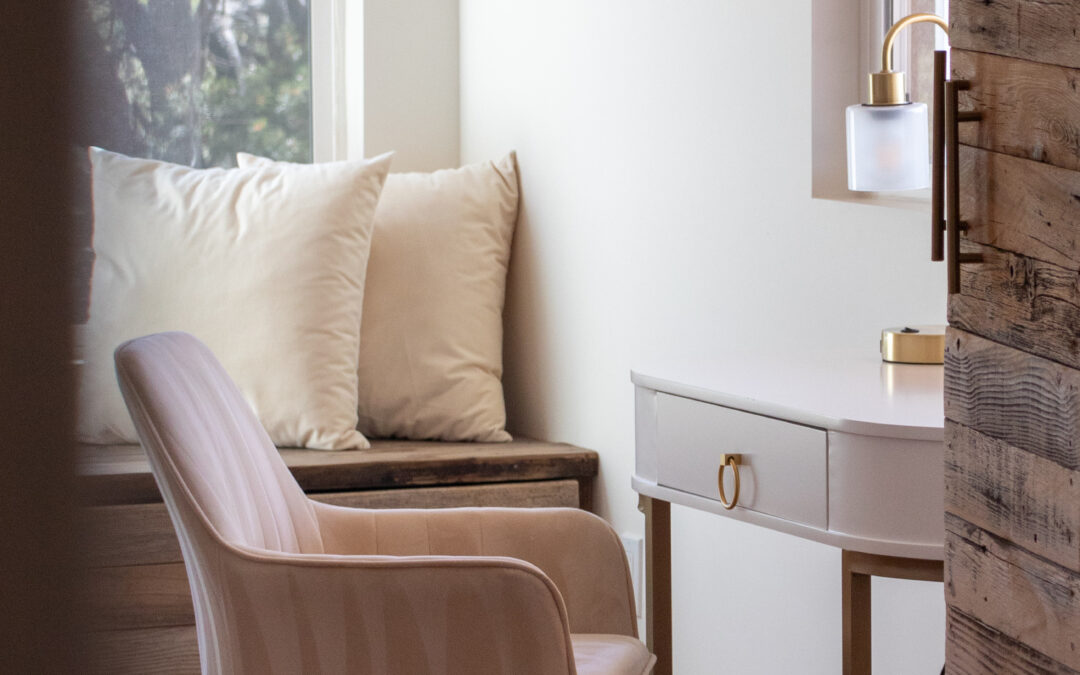
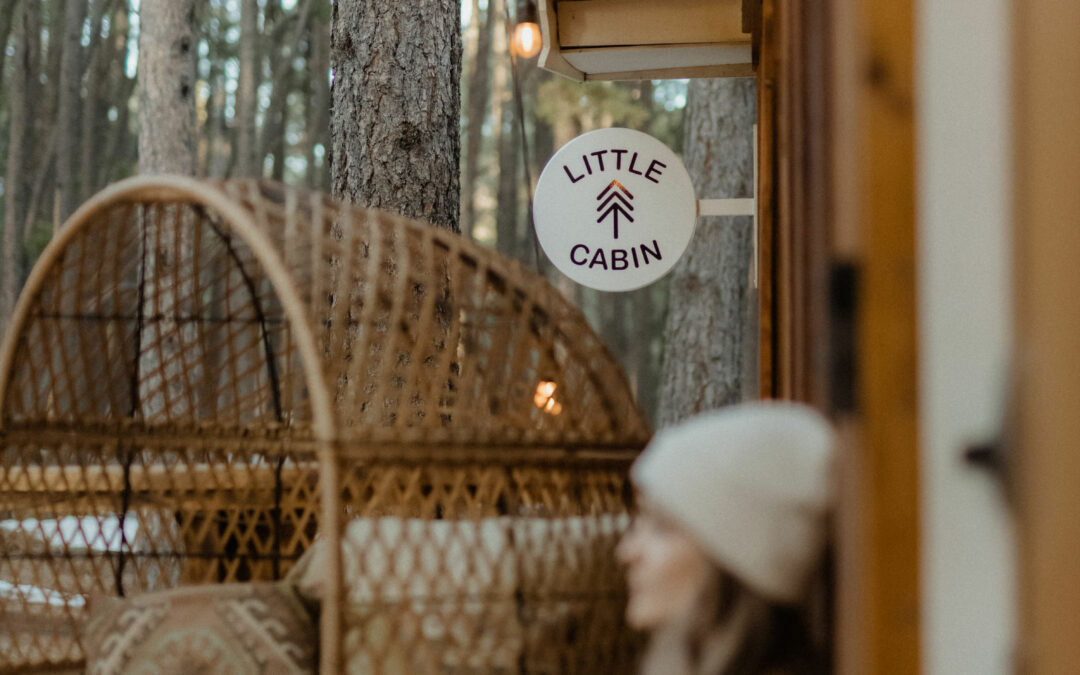

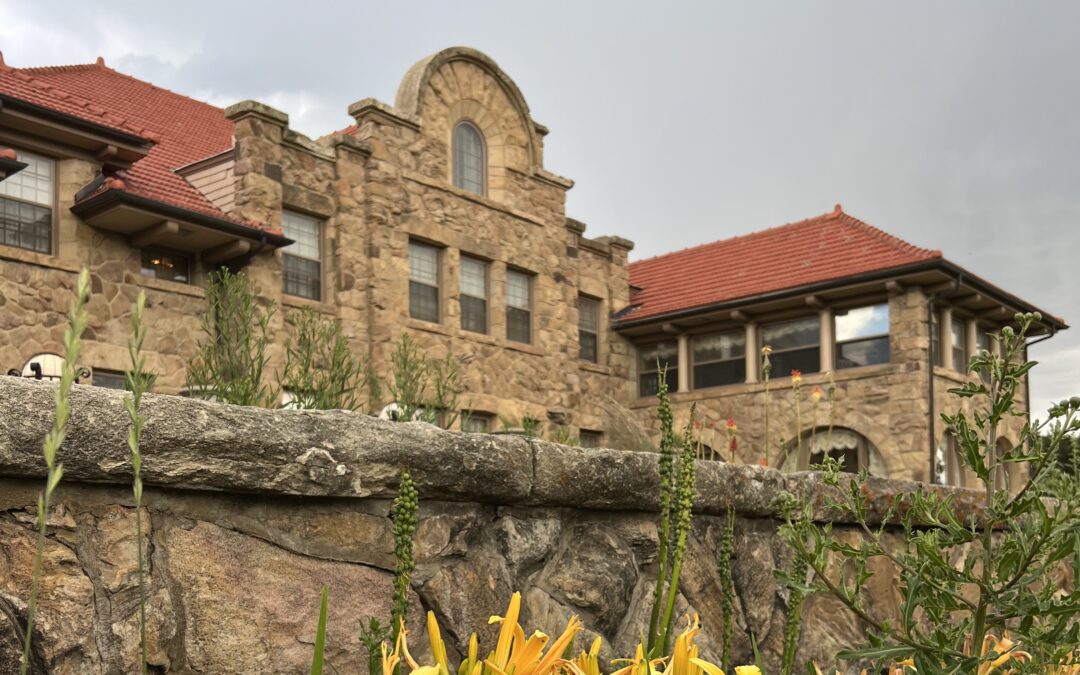


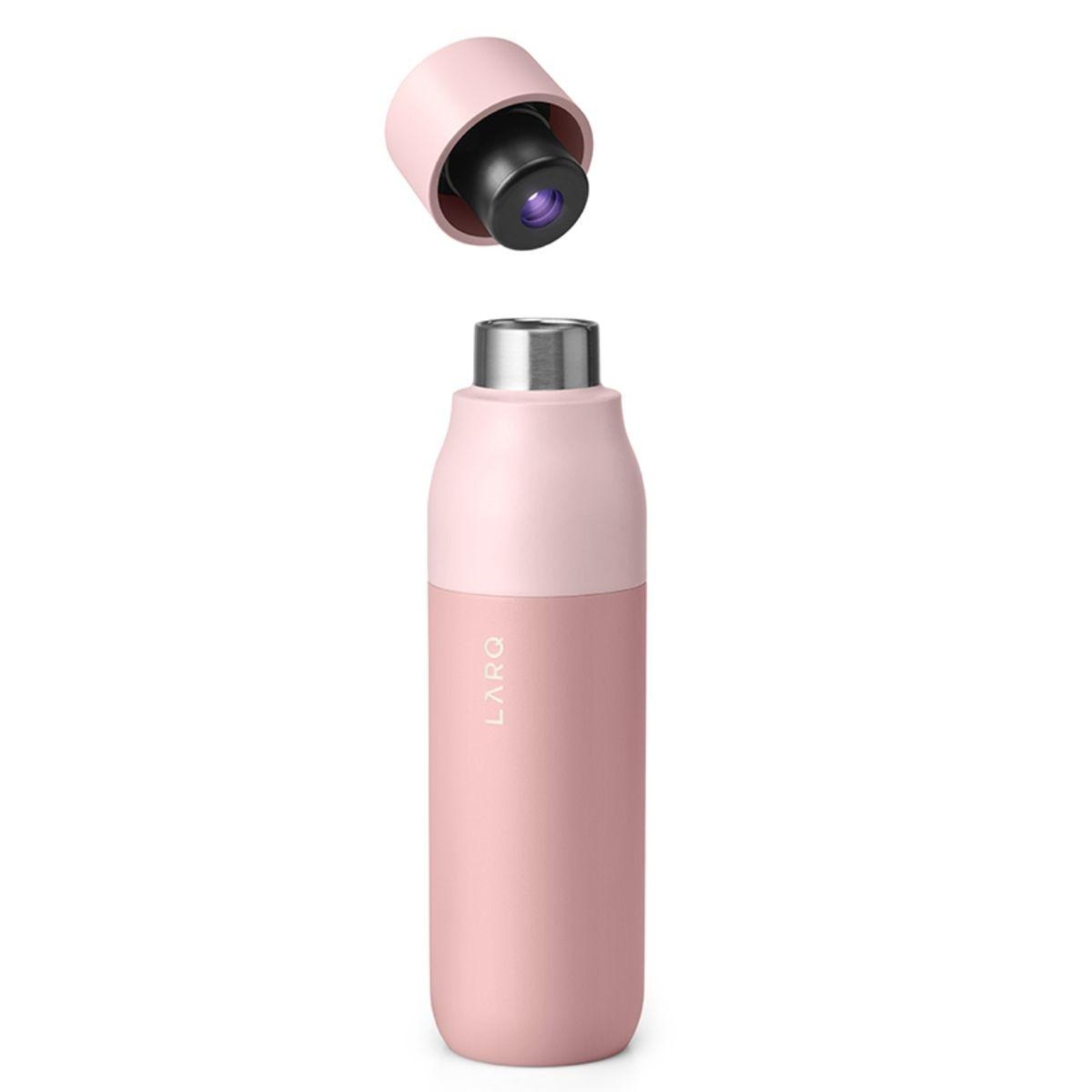
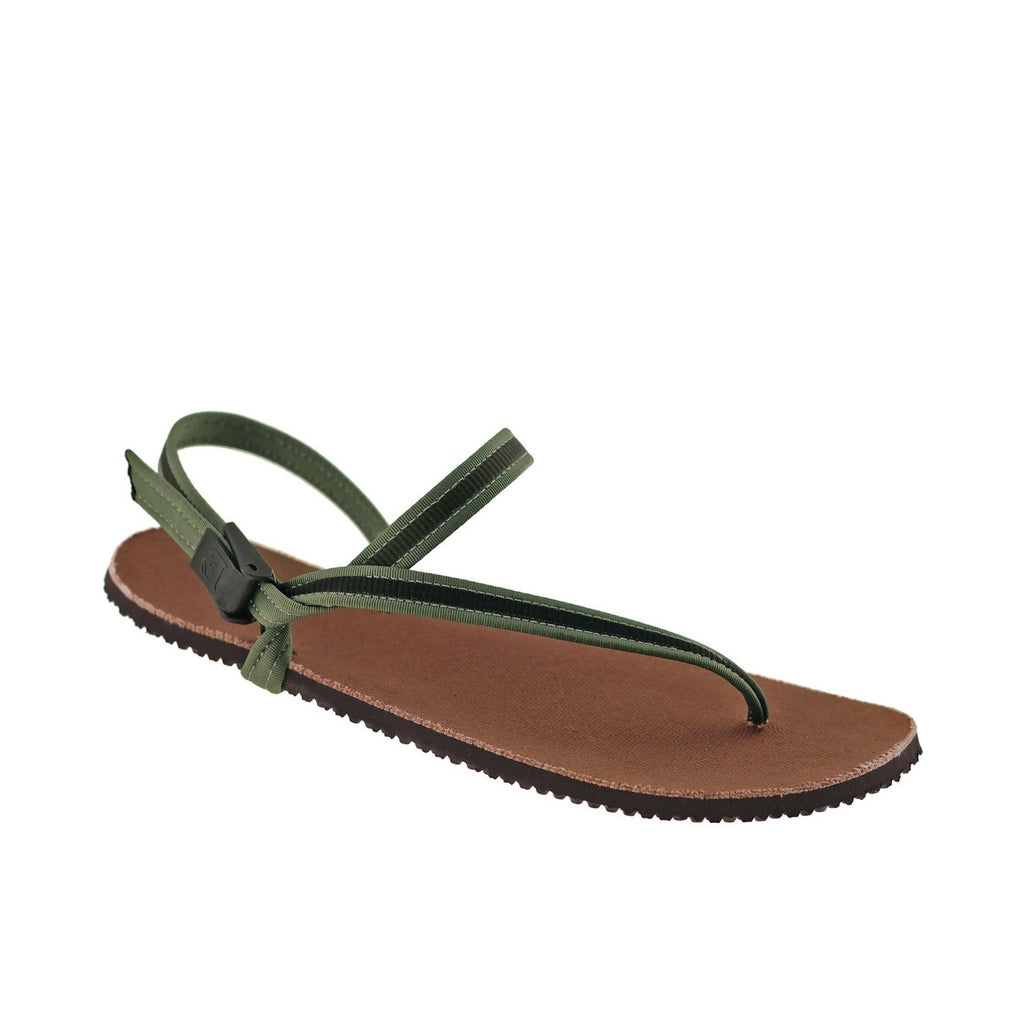


Mia, you’re the best! If I ever get out of Taos and go south, I hope to follow your guide. And if you meet people who want a personal meditation guide, send them my way. Thanks and bon voyage.